
FAMOUS NINETEENTH AND EARLY TWENTIETH CENTURY BRITISH CATTERIES
In her "Book of the Cat," Frances Simpson gives details of cats bred in several notable catteries in the British Isles. Here I have simply listed the cattery premises that are depicted and described to allow comparison between them aswell as comparison with later catteries.
ALDERMOOR - MRS SINKINS
MRS SINKINS AND HER PETS AT ALDERMOOR. The Queen, 11th July 1908
Mrs Sinkins is well known amongst cat lovers as an enthusiastic bleeder and exhibitor of smoke Persian cats. This handsome breed is not very popular, and needs a few fanciers with energy and perseverance to take it up. It was about ten years ago that Mrs Sinkins started with a shaded silver female bred to a smoke, and from this strain came the famous Teufel, whose name is a houseehold word in the cat fancy. This "king of smokes, which was born June, 1900. and died in April, 1906 from a severe attack or jaundice, was a noted prize winner, and gained as many as nine championships during his show career. No finer smoke Persian was ever penned though he had two rivals in the well known winners, Backwell Jogram, owned by Mrs James, and Rani, belonging to Mrs Stead. Mrs Sinkins was fortunate in securing from Miss Powis one of Teufel s sons, and now Teufel II. reigns in his lather's steam at Aldermoor, Colonel and Mrs Sinkins's country place, situated about four miles from Southampton. The house was originally a farmhouse, and is of a delightfully quaint rambling cottage style. The garden was a blaze of colour on the occasion of my visit in June, roses climbing up the old walls, covering arbours, and trailing over rustic archways, while there were borders of all the sweet-smelling old-fashioned flowers such as found favour with our forefathers.

The whole estate comprises fifty acres, and the woodland portion of fourteen acres was delightful, when the sun was registering 130 degrees. I first visited the stables, where three fine horses were standing, and in an adjoining louse box nine frisky young kittens were enjoying life. These consisted of five smokes and four silvers, about eight weeks old. Two of the silvers promised to be very pale, and were by Mrs Sinkins s queen Sylvie and Mrs Wellbye s noted stud Milord. The smokes were beginning to get the desirable white undercoat and orange-coloured eyes. Teufel II is the father, and Joan and Minouche share the honour of mothering them. Nothing, however, pleased Sylvie, the silver, better than to gather all the kittens to herself and endeavour to feed the multitude.
One of the smokes (a female) Mrs Sinkins intends keeping to see how it turns out. It is now the flower of the flock; but smokes are fickle, and the most clever breeder may easily find that the ugly duckling of the litter turns out the best and biggest prize winner. These fine kittens are fed on Bengers or Mellin s food, with a meal from a sheep s head once a day, while they also have plenty of fresh air and freedom. One of the tiny silvers followed me across the garden into a distant dell in the wood, where Teufel II has a charming homestead, during the summer, under sheltering pines. Minouche was also quartered here in another movable cattery. This smke queen is a fine specimen, with a grand, broad head, and good orange eyes. She has taken many prizes, and comes from Mrs Cartwright s famous straing. On returning through the woods I came across one of the hen runs, where some prize-bred white Leghorns are kept, silver Wyandottes being in another, and with both these breeds Mrs Sinkins has won championships. In the meadow opposite the house were four Jersey cows.
Colonel Sinkins cannot be said to favour the cats, but it was evident that Shah, the household pet, a nice silver neuter, was not only tolerated, but openly adored. This was clearly demonstrated when he climbed up his master's chair at dinner and seated himself on the Colonel's shoulder. Colonel Sinkins's pets also include two old English sheepdogs, and a wire-haired fox terrier. Mrs Sinkins is president of the Southern Counties Cat Club, and the two shows held at the Horticultural Hall, Westminster, in 1907 and 1908, under her excellent management, have proved the greatest success. She is now endeavouring to organise a cat fanciers' association, which it is hoped may be a representative institution for the purpose of forwarding the interests of the cat fancy generally. This society is not intended in any way to rival or encroach on the National Cat Club, yet, it would be greatly to the advantage of the whole fancy if the senior club could be induced to join forces with the various specialist societies and junior clubs, and so form one large representative association. Mrs Sinkins has the good wishes of a very large majority in her desire to promote the welfare of the entire cat fancy. - FRANCES SIMPSON.
BACKWELL MRS JAMES

Mrs. James's bred smoke Persians in her old-fashioned garden surrounding the Grange at Backwell.
BERESFORD LODGE LADY DECIES (GERTRUDE WILLOUGHBY)
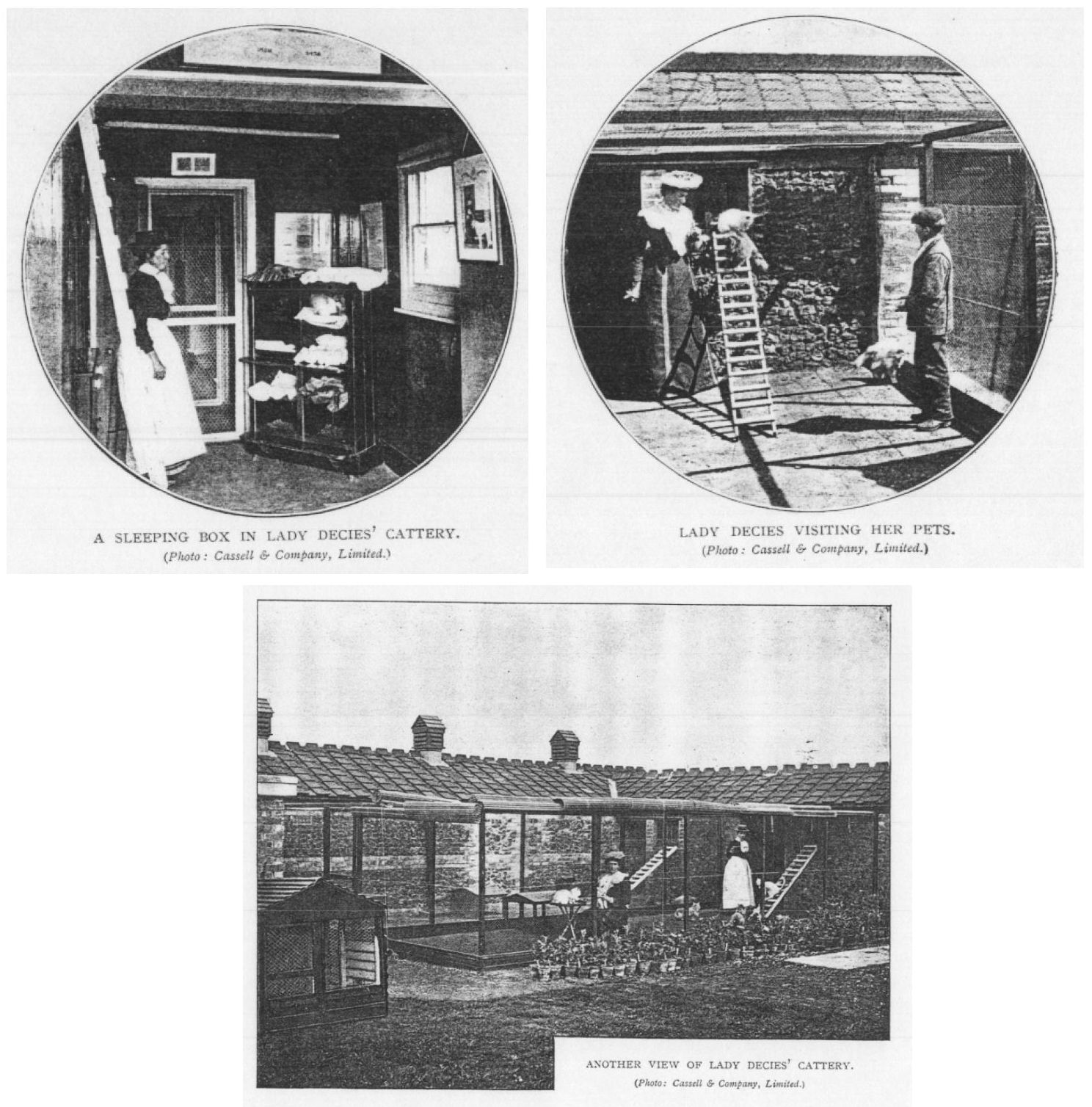
Lady Decies' catteries were at her summer residence at Birchington-on-Sea. The main cattery was large and in a sheltered portion of the grounds. The runs are arranged with boxes, benches, chairs, and ladders, and the cats had comfortable brick-built sleeping places. Lady Decies installed wooden blinds on the sides and tops of her cattery in order to regulate the strong sea breezes and strong sunshine. The floors were made of wood, covered with cork carpet, and were raised about a foot from the ground to ensure airflow beneath and prevent damp.
The stud cats had their own single houses with good-sized wired-in runs, and luxurious and cosy sleeping rooms. Inside her house Lady Decies set aside three rooms for her cats: two rooms for expectant and nursing females and a third room used as the cats kitchen. She employed a woman and a boy to attend to the needs of her cats. Lady Decies was especially well known for her silver Persians.
BIRKDALE MISS SOUTHAM
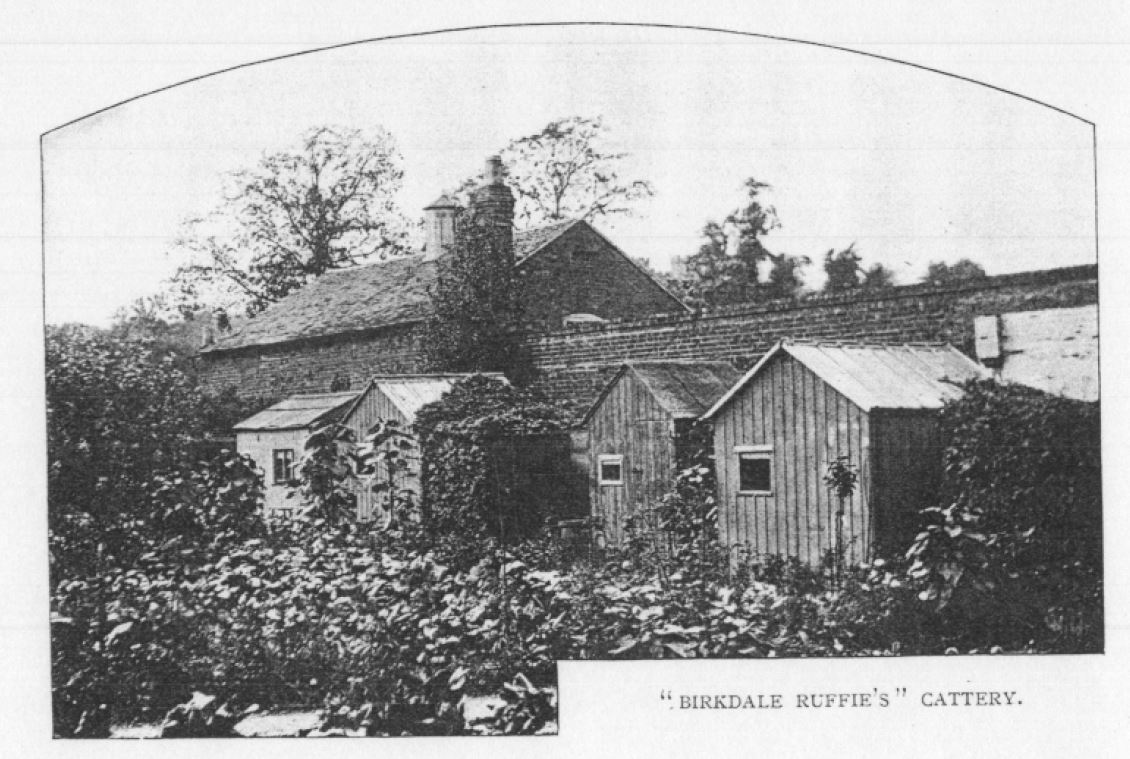
The Birkdale cattery (known as Master Ruffie s cattery after its most famous inhabitant) was built on the principle of shepherds' huts, each house having a separate wire run, with shrubs planted, and a thick wall of ivy in the background, which gave it a picturesque appearance. In summer a mass of luxuriant hops provided shade from the hot sun. The houses were warmed by gas stoves and were fitted out with curtained windows, carpets, wickerwork armchairs, and cushioned benches. It housed Master Ruffie (Birkdale Ruffie s son) and his seven feline playmates.
The cattery had appropriated the sunniest corner of the garden, their houses-having the much desired southern aspect. When Miss Southam was away from home, the cattery was left in the care of the gardener. The one bone of contention is that the cats had appropriated the sunniest corner of the garden, their houses having the much desired southern aspect, which the gardener coveted for his peaches and early peas.
BISHOPSGATE CATTERY LADY MARCUS BERESFORD
The Bishopsgate cattery comprised a cat cottage, where the attendant lived and where the other apartments were especially fitted up for the cats. This housed the Siamese cats and the windows faced due south to ensure plenty of sunshine and warmth. Opposite the cottage were some of the cat houses, and in the centre was the kitchen. There was also a grass run, securely wired in, which was used as an outside exercise area. In the hot summer weather this was shaded by the spreading beech trees of Windsor Park.
The stud cat had their own houses with sleeping places and spacious runs. The space in the centre in front of these runs was used as an exercise ground for the females and kittens. The garden-house cattery was a bower of roses in the summer and ivy-clad retreat in winter. The garden-house was divided into two apartments which were generally used for mothers and kittens. There were shelves along the windows so the cats could sunbathe. There was also a cats cemetery under the trees and the graves were marked with inscribed white tombstones. Lady Marcus Beresford kept many different breeds and was noted for her Siamese cats.
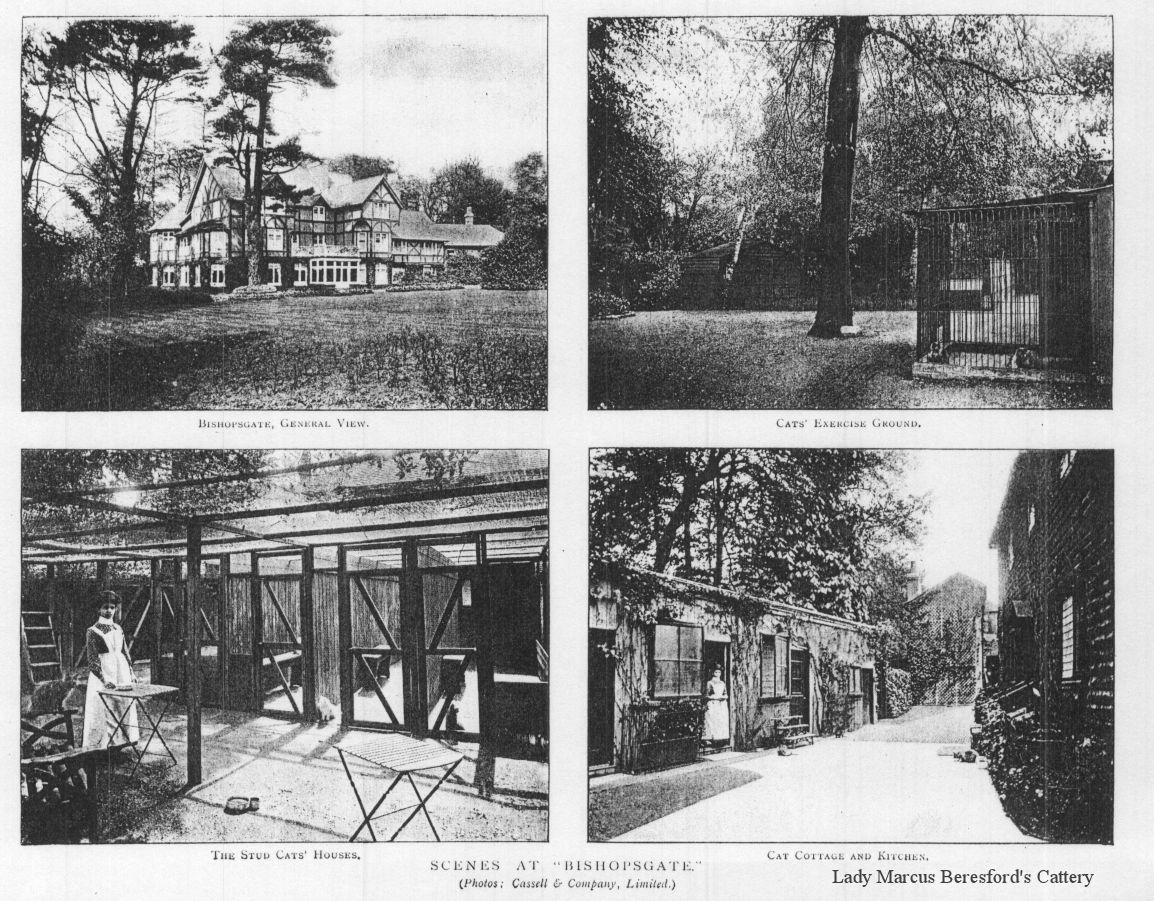
LADY BERESFORD AND HER CATS (Boston Evening Transcript, February 11, 1899) "Lady Marcus Beresford has for the last fifteen years made quite a business of the breeding and rearing of cats. At Bishopsgate, near Egham, she has what is without doubt the finest cattery as such establishments are called in the world. "I have applications from all parts of the world for my cats and kittens, said Lady Marcus, in a chat about her hobby, and I may tell you that it is largely because of this that I founded the Cat Club, which has for its object the general welfare of the cat and the improvement of the breed. The presidents of the club are Lily, Duchess of Marlborough, the Duchess of Wellington, and Lord Marcus Beresford. My catteries were established In 1890, and at one time I had as many as 150 cats and kittens. Some of my pets live in a pretty cottage covered with creepers, which might well be called Cat Cottage. No expense has been spared in the fittings of the rooms, and every provision is made for warmth and ventilation. One room is set apart for the girl who takes entire charge of and feeds the pussies. She has a boy who works with her and performs the rougher tasks. There is a small kitchen for cooking the meals for the cats, and this is fitted with every requisite. On the walls are racks to hold the white enamelled bowls and plates used for the food. There is a medicine chest, which contains everything that is needful for prompt and efficacious treatment in case pussy becomes sick. On the wall are a list of the names and a full description of all the inmates of the cattery, and a set of rules to be observed by both the cats and their attendants. These rules are not ignored, and it is a tribute to the intelligence of the cat to see how carefully pussy can become amenable to discipline if once given to understand of what that discipline consists.
Then there is a garden cattery. I think this is the prettiest of all. It is covered with roses and ivy. In this there are three rooms, provided with shelves and all other conveniences which can add to the cats' comfort and amusement. The residences of the male cats are most complete, for I have given them every attention possible. Each male cat has his separate sleeping apartments, closed with wire and with a run attached. Close at hand is a large square grass 'run and in this each gentleman takes his daily but solitary exercise. One of the stringent rules of the cattery is that no two males shall ever be left together, and I know that with my cats if this rule were not observed both in letter and precept it would be a case of when Greek meets Greek.' I vary the food for my cats as much as possible. One day we will have most appetizing bowls of fish and rice. At the proper time you can see these standing in the cat kitchen ready to be distributed. Another day these bowls will be filled with minced meat. In the very hot weather a good deal of vegetable matter is mixed with the food. Swiss milk is given, so there is no fear of its turning sour. For some time I have kept a goat on the premises, the milk from which is given to the delicate or younger kittens.
BOSSINGTON CATTERY - MRS COLLINGWOOD
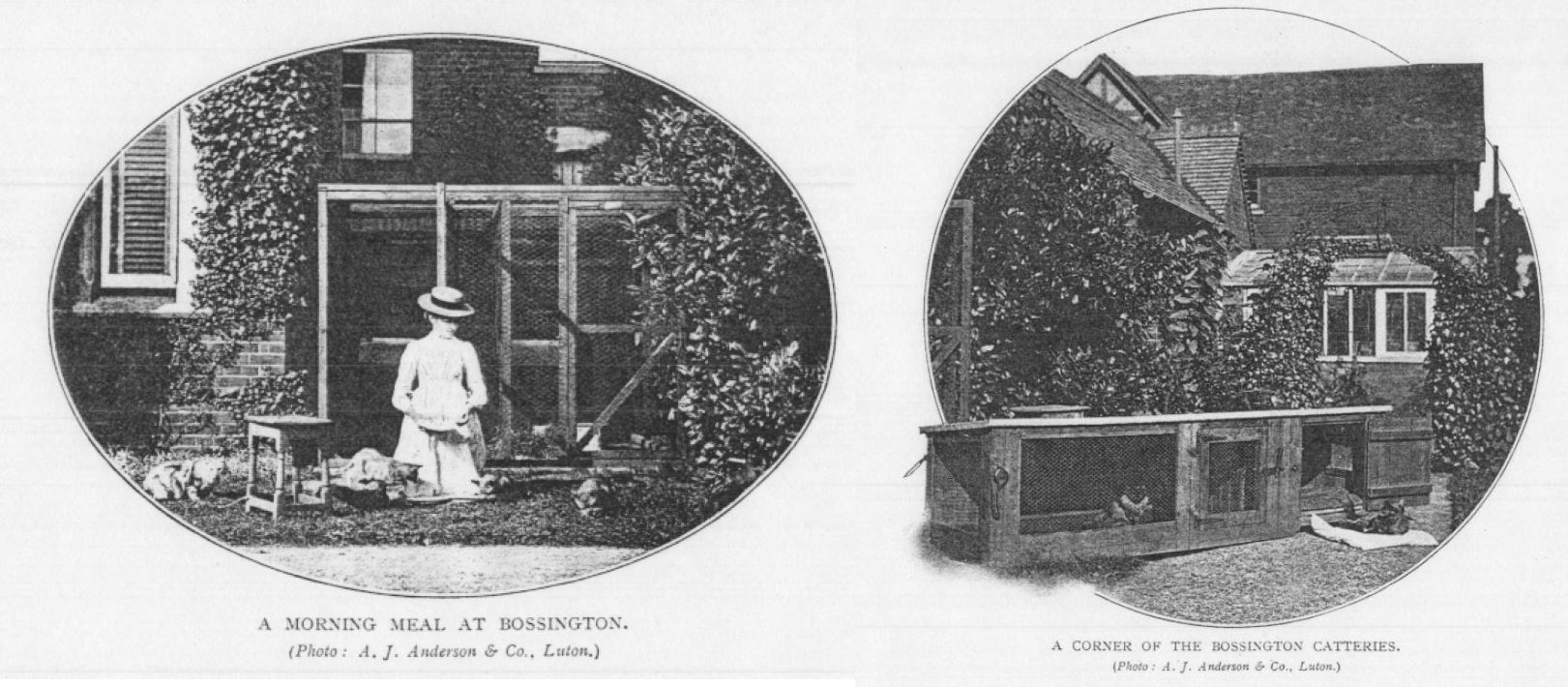
Bossington Cattery at Leighton Buzzard belonged to Mrs Collington who admitted to a great difficulty in keeping the number of cats down to about thirty. These were equally divided between long-and short-haired breeds. The five acre grounds contained twelve cat-houses. The smaller houses were mostly on wheels and the larger houses were kept for females and their families. Sometimes a corner of the hay-loft was set apart for nursing mothers. The neutered male cats were given their liberty during the morning, and in the afternoon the females enjoyed outdoors time. Mrs. Collingwood did not keep her own stud cat, but she had neuter pets that had their run of the house, and took their meals in a corner of the dining-room.

MRS COLLINGWOOD AND HER PETS. The Queen, 13th October, 1906
A visitor to Mr and Mrs Collingwood's charming home near Leighton cannot fail to be struck with the animal-loving element which seems to pervade the whole place, for the maids appear devoted to the numerous indoor pets, and in the stable and grounds the men evidently take a lively interest in what may be called the Bossington Zoo. There are no kennels, in the usual sense of that word, but nevertheless there are seven dogs and two puppies. Mrs Collingwood has never been without at least one dog, and has favoured many breeds. I remember, for instance, a French poodle called Fee Fee, and a well-beloved fox terrier whose death took place last year, leaving a veritable blank in the homestead; but at the present time toy French bulldogs are in the ascendant, and there are also two wonderful Skyes, of which their mistress is justly proud. They walk with a dignity befitting their long, tailing silken coats, while a black Chow, of evidently a very independent nature, roams the grounds at will, and takes a day and a night off occasionally. Monsieur Loubet, the toy bulldog, was purchased by Mr. Collingwood in 1905, and in March this year made his debut at the Toy French Bulldog show held in the Royal Horticultural Society's hall at Westminster. His mistress was really ignorant of the treasure she possessed, and, therefore great was her surprise when the French "president" achieved much success.
At the Ladies Kennel Association show held at the Botanical Gardens in June Monsieur Loubet was again exhibited, and attracted the notice of the judges. It seems that the position of the French toy bulldog has been very unsettled in the pest, but the Kennel Club now recognise the breed, and a specialist club has been formed. The Skyes, have only been exhibited once, when they won in the classes in which they were entered, being shown in line form. Their long coats are brushed and combed every day, and the dogs know the boy's whistle at a certain hour, when they run and jump up on the toilet table. They are washed about once a week.
And now concerning the cats! It was my good fortune to be on the lawn at feeding time when the boy and girl who are caretakers of the pussies rattle a stone in a plate, which is the signal for some twenty or thirty graceful creatures to appear running helter-skelter from all parts of the garden and grounds. Mrs Collingwood s speciality is silver tabby short-hair cats, and at the time of my visit there were about twelve specimens of this charming variety, besides two promising kittens. Nowhere do cats of this fascinating breed show to greater advantage than when sporting themselves on the green grass. Miss Toodles, the wonderful female bred by Mrs Collingwood, is a champion among champions, and her list of prizes forms an interesting and astonishing record. This beautifully marked silver tabby is now in robust health and superb condition, but in the early spring she suffered from a bad internal abscess, and only the devoted nursing of her anxious mistress brought her through. In my honour Miss Toodles was wearing a smart blue ribbon round her neck, to which was attached her gold championship medal. Brown tabbies were also much in evidence, and I noticed several fine specimens of Mrs Collingwood s own breeding. I was surprised to see a pair of Abyssinians, as these cats are not to everyone s fancy, but there owner hopes to possess some choice specimens of this variety.
It was in 1901 that Mrs Collingwood first became a cat exhibitor, and sent a blue neuter to the Westminster show, whereat David took first prize, and his mistress was forthwith launched into the cat fancy. Year by year by leaps and bounds she has gone further and further towards the top of the tree, and has proved herself a true fancier in every sense of the word. She frequently judges, is always foremost in guaranteeing classes, is most generous in offering specials, and makes a large number of entries at all the leading shows, while she invariably accompanies her pets. Blue Persians were this lady s first love, and to blues she has returned with increasing zest. I was charmed with a young female bred at Bossington, which should indeed be hard to beat when in full coat. Her head is perfect, her colour the desirable medium, and her eyes as gold as guineas. A fine blue male, bred by Lady Duckworth, and a female with marvellous orange eyes were the only other blues on view, but three or four were absent; in fact, about sixteen cats and pets are boarded out.
The great charm of the Bossington establishment is that there is no cattery at all, fr the cats have unlimited freedom, and the marvellous way in which they all agree and never wander away is as astonishing as it is delightful. Truly the cat and dog life at Bossington is one of pleasantness and peace. There are about forty cats on the premises, and some are altogether house pets, but others inhabit the pretty little movable houses which are scattered about the grounds. These are transferred from time to time n to different pieces of land, and thus entirely fresh soil and grass are provided. I was greatly struck with the beautiful way in which these cat houses were kept. Some were like Swiss chalets, and had white curtains to the little windows, while inside were also easy chairs, wicker tables, and benches. Mrs Collingwood is a believer in raw meat diet, and all the cats have this twice a day.
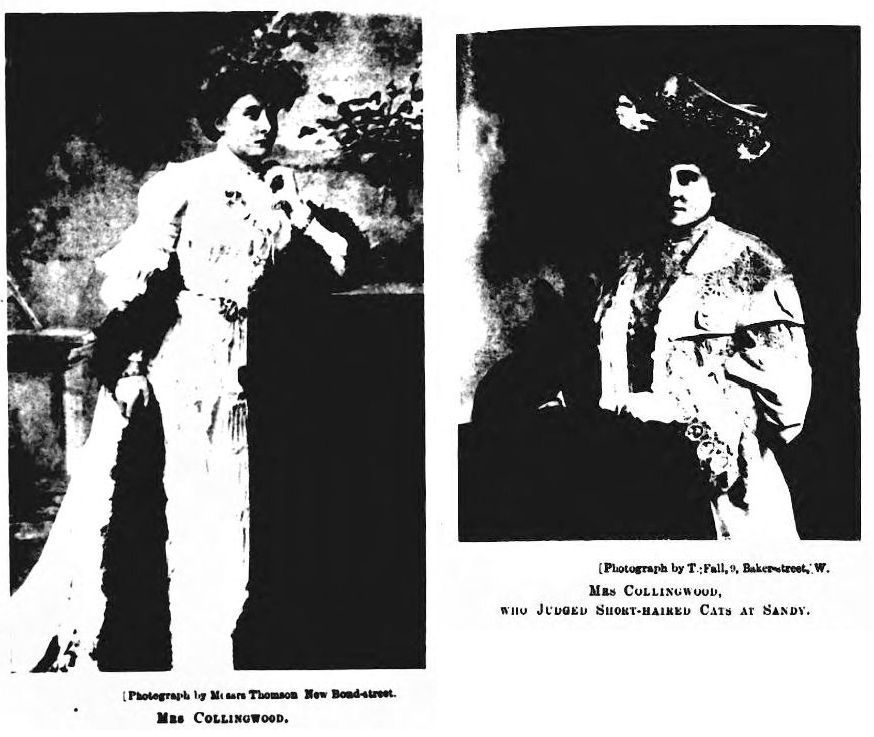
A boy and girl attend to the wants of all the dogs and cats, and a charwoman from the village comes to lend a helping hand when a thorough cleaning of the numerous houses takes place. There are four neuter cats, and two of these are Mr Collingwood s special pets; but he must be a believer in the saying that handsome is as handsome does, for Darkie and Blackie are not quite up to the standard of the other cats at Bossington. A pair of good cream Persians are recent additions to the cattery, and a little orange kitten which I christened The Imp makes a bright bit of colour scampering amongst his playmates of more sombre tone.
When the luncheon gong sounded it was clear that many of the pussies welcomed the sound, and took up their positions with an air of hopeful expectancy. There was not noisy clamouring round the table, but all contributions were thankfully received. Miss Toodles, probably by reason of her exalted status in the cat world, was allowed to perch on the corner of the table for her tit-bits. I must not forget to mention that a jersey cow is kept in the field adjoining the house, so that a plentiful supply of milk is obtained for all the residents at Bossington. An old sow with a fine litter of twelve should be included in the list of livestock on the premises. - FRANCES SIMPSON
BRAYFORT CATTERY - MISS WHITNEY

MISS ROSAMUND WHITNEY AND HER BROWN TABBY PERSIAN CATS -The Queen, 14th July 1906
It was only about eight years ago, on receiving a present of a brown tabby Persian kitten that Miss Rosamund Whitney first entered the ranks of cat fanciers, and she has ever since remained faithful to this breed, which until lately has been rather looked down upon, while no specialist club has yet been formed to uphold and bring forward the many fascinating points in favour of brown tabbies. Miss Whitney herself has done a great deal to help on this variety, and is always generous in guaranteeing classes, as well as offering special prizes at all the leading shows. But it is not only financially that she has assisted the cause of her favourites, for this enthusiastic lady, who lives in Dublin, has frequently come over specially to act as judge. As an exhibitor of brown tabbies she has made her name, and her beautiful neuter Persimmon Laddie will always rank as the finest specimen of this breed, for in colour, markings, size, and coat he has never been surpassed. He did not live long, however, to wear his laurels, and his loss was indeed a grievous one to his devoted mistress. It was in 1899 that Miss Whitney purchased a wonderful brown tabby female called Fina, which has achieved great success in the show pen, and still holds her own in spite of her age. Her sire was the son of the famous champion Birkdale Ruffie, and inherits his gorgeous colouring, while her sister, Princess, is very much of the same type of sable tabby and has also done a lot of winning. Brayfort Honey is a well-known victor, and Miss Whitney has recently purchased a lovely brown tabby female of Mrs Drury s breeding. Tip Topper, indeed, does not belie her name, as she is always well to the fore whenever exhibited.
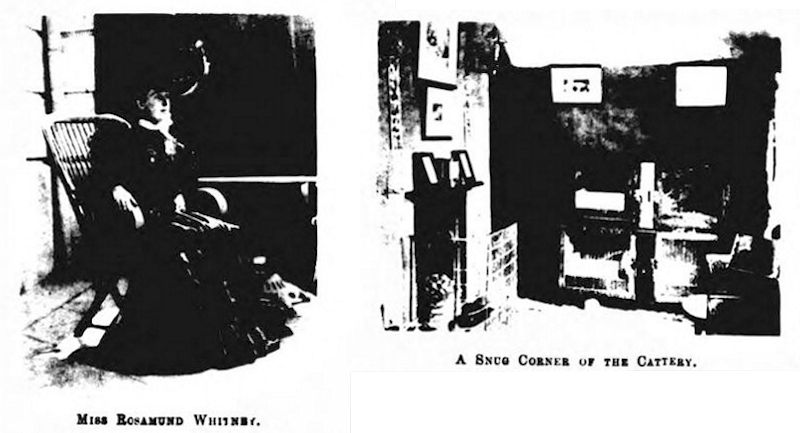
A brown tabby stud of great promise has lately been added to the Brayfort Cattery, making the present inmates eight in number. Miss Whitney, being a careful and clever breeder, never overcrowds her establishment, while all her cats are veritable pets, and looked after by herself. They are fed three times a day, and in the coldest winter never have any artificial heat. Their mistress is in the position of being able to say that she has never lost a cat after a show, and attributes this to not leaving them in their pens during the night. This lady, although in Dublin, spends several months of the year at her country seat at Bray, and, needless to say, her pets all accompany her on the summer outing. It is the great ambition of this enthusiastic cat lover to breed a brown tabby minus the white lip, which is looked upon as defect, though all the well-known champions of past fame have failed in this point. Many fanciers are of opinion that, as the wild and original cat had the white lip, and as the tiger to which the brown tabby cat is near akin is also freely marked with white about the chin, it is a natural feature and that the dark-lipped and brown-chinned tabbies are only freaks. Be that as it may, however, Miss Whitney says, "I have secured coat and colour, and expect to attain the other desirable points in the near future." "Nothing succeeds like success," and the following list of this exhibitor's victories up to January, 1906, gives some idea of her patience, perseverance, and enterprise: First prizes, 57; second, 35; third, 14; special prizes, 82: championships, 21; cups, 8. - FRANCES SIMPSON
BRIARLEA - MISS HARPER
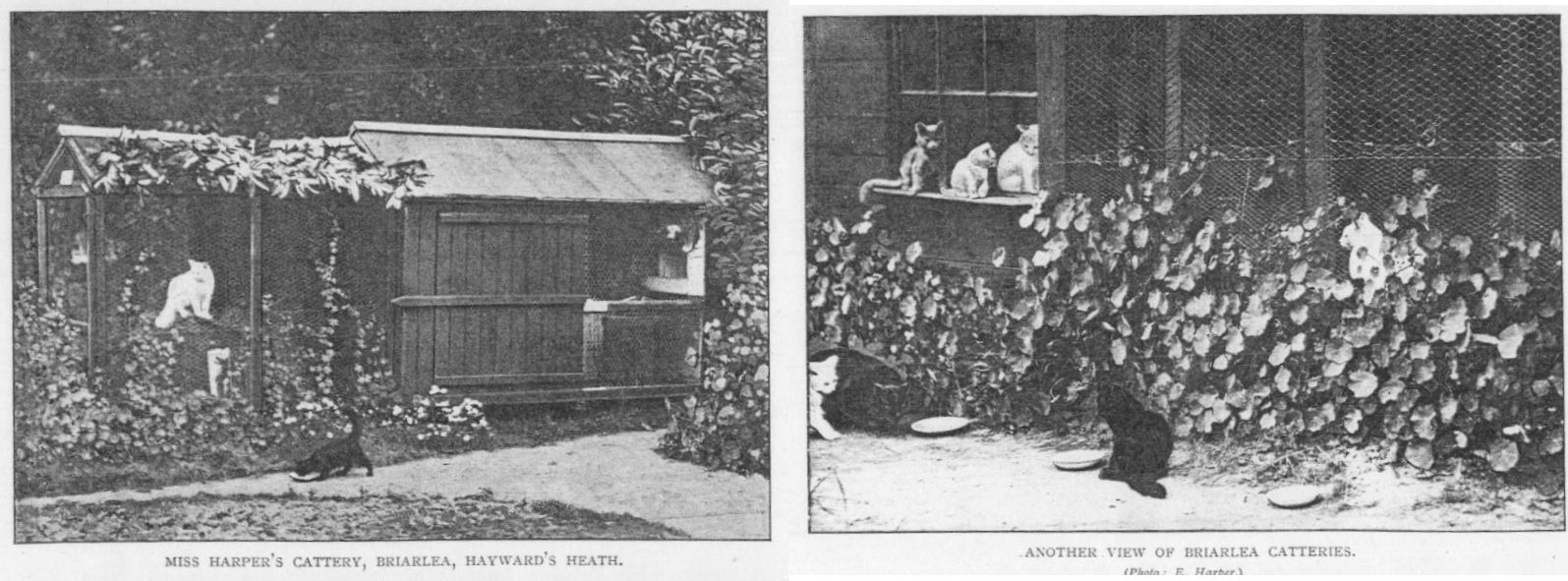
DINGLEY HILL MISS ANDERSON LEAKE
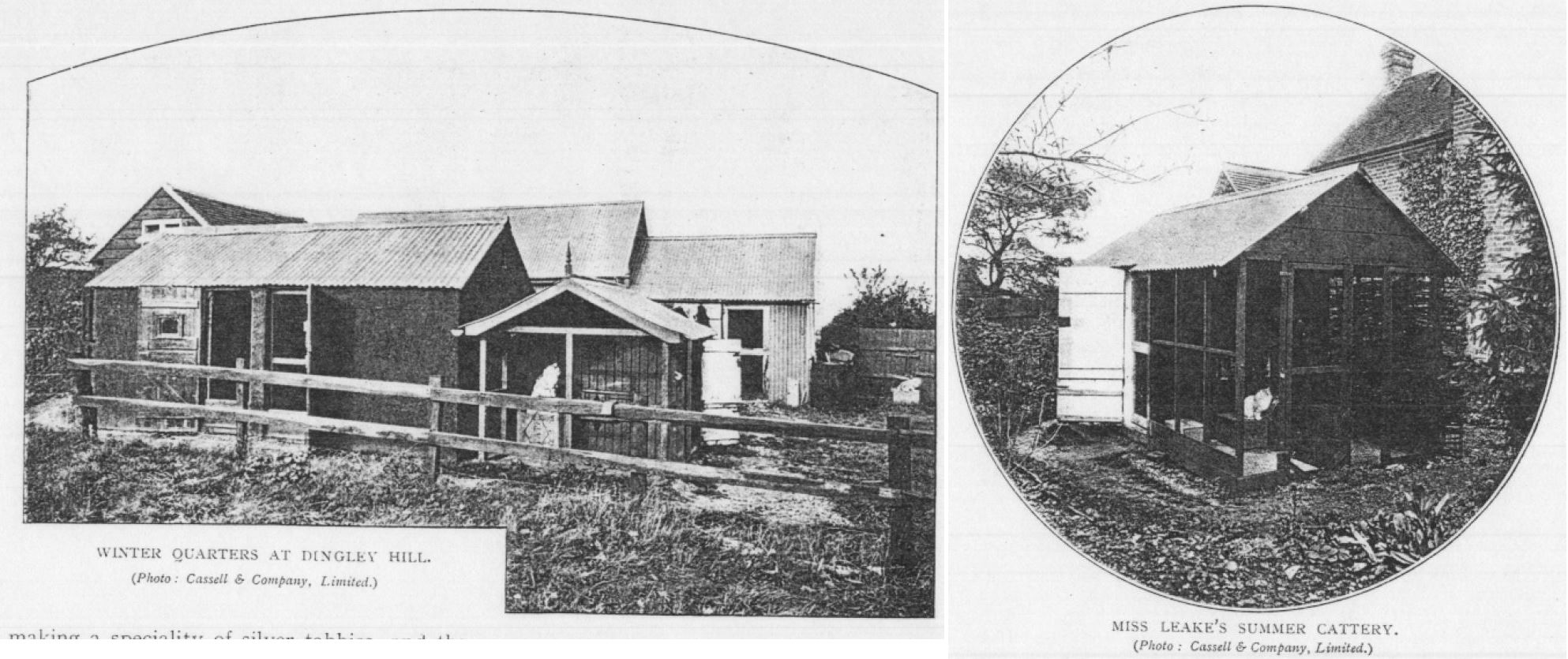
Miss Anderson Leake bred silver tabbies at her cattery at Dingley Hill, Bradfield, near Reading.
HOLMWOOD MISS JAY
NOTABLE CATS AT HOME Gentlewoman, 24th December 1898
Pussy is the predominant partner in the current Ladies Kennel Journal, which largely concerns itself with the N.C.C. Show. The "Notable Cats at Home" page s are worthily filled this month by a description of Miss Jay's catteries at Holmewood, Putney Hill. This lady being a great enthusiast, one is not surprised to learn that she has model housing accommodation for her pets. "The deck of a naval vessel could not be smarter or more perfect in every detail than this cattery, and it possesses that highest attraction - individuality." So says the writer, who further mentions that each of the apartments in the cattery is a good size and loftier than an ordinary room. The walls are distempered cream colour, and the floors are of red brick. Careful attention to detail, personal attention, and judicious selection are no doubt the causes which make the Holmewood prize-list such an extensive one.
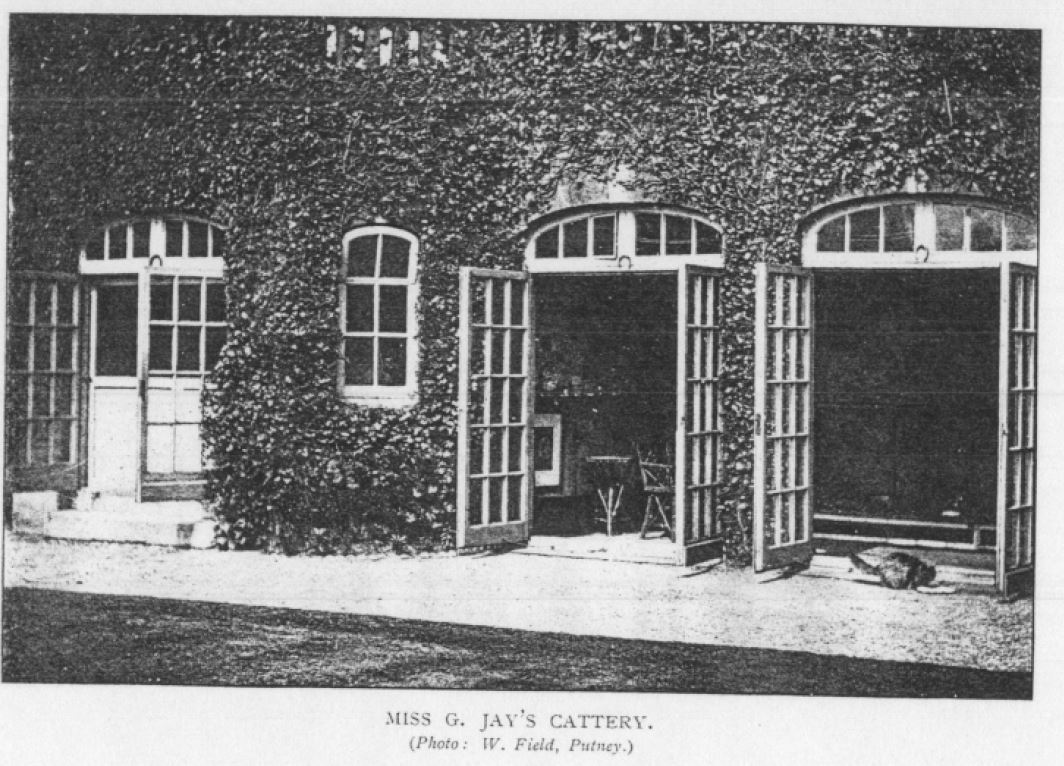
THE HOLMWOOD CATS AND OTHER PETS The Queen, 17th March 1906
Miss Gertrude jay is well known in the cat fancy as a keen enthusiast and breeder of Blue Persians. It was in 1891 that the Holmwood Cattery was started, and Trixie, a blue female, was the first inmate, which wonderful old cat is still in Miss Jay s possession, looking exceedingly fit and well. She has never had a day s illness in her life, but she has never reared a kitten, and, although fosters have been in readiness to take over her kittens, the latter have all died, but Trixie lives on, and is adored by her mistress. It is however, chiefly in connection with a marvellous specimen of a blue female called The Mighty Atom [Champion Holmwood Mighty Atom] that Miss Jay has made her name, for nothing has ever been exhibited to compare with this superb female as regards beauty and shape of head. She twice carried off the highest honours for the best cat in the show at the Crystal Palace, though it is true that The Might Atom lacked the orange eyes which of late years has become so essential in blues on the show bench; but no judge, however up to date, could even now pass over such a perfect type of cat, despite her one fault. This grand female, however, is no more, for three years ago she died, to the great grief of her owner.
Miss Jay is fortunate, however, in having some descendants of The Mighty Atom, as one daughter and four granddaughters of this noted queen are to be seen at the Holmwood Cattery. They are quite a show in themselves, with splendid long coats, and heads buried in fluff and ruff, and lovely spreading tails. There were seven females in one of the spacious divisions of the Cattery when this establishment was visited, and each and all were in grand coat, possessing that sell-groomed appearance which bespeaks the great care and attention that must be bestowed upon them. In another compartment were two big burly blue males, with even longer and thicker coats than the females, and these cats, by name Holmwood K. and Wyland, appear to live together in perfect peace. Holmwood K. owns San Toy, Mrs Norris s well-known cat as his sire. Miss Jay does not believe in any heat in the Cattery, and gives only one meal a day to cats, with as much milk from the Holmwood estate cows as they like to drink. The meal consists of raw meat one day and fish the next, and certainly these cats are well up to weight, showing splendid limbs and abundance of flesh.

The Holmwood Cattery is beautifully situated on the top terrace of the lovely old garden which surrounds one of the oldest houses on Putney Hill, and has been made in one of the conservatories, the outer walls of which are covered with creeping ivy and roses, while inside they are papered with prize cards of cats and poultry, for Miss Jay is also an ardent fancier of blue Andalusians. There are sixty head of poultry at Hohnwood, and in 1905 Miss Jay took twenty-three prizes with her birds. For ten years this painstaking lady has been endeavouring to produce a special strain, succeeding in a wonderful degree by careful inbreeding, and she is at present the only owner of blue Andalusian bantams in England. She has sold some birds at 5. 5s. each to America and Belgium.
But to return to the cats. Few people in the fancy are aware that, Miss Jay goes in rather extensively for short-haired tortoiseshells, and these are chiefly Manx. There were quite a number of these quaint creatures in what might be called the stable cattery. It is some years ago since Miss Jay exhibited any of her beautiful blues, and though she has ceased showing, is still a president of the Blue Persian Cat Society, and has often kindly acted a judge for this flourishing specialist body. Beside being a competent judge, Miss Joy is most painstaking and thorough in her work.
It would be a west pleasure to everyone in the cat fancy if this lady would once again enter the ranks and become an exhibitor. I have every reason to believe that had she been at at home at the time of the recent Reading show some of her beautiful blues would have adorned the show bench on that occasion. To write about Miss Jay and her pets and not to mention Fritz would indeed be a grave mistake, for this much-beloved fox terrier is Miss Jay's most constant and faithful companion, going everywhere with his devoted mistress, even to cat shows! In the Holmwood drawing-room attention is attracted by yet another pet, in the shape of a grey African parrot, and on the occasion of my visit he was particularly talkative. He has been taught to call out "Puss, puss!" "Gertrude!" "Mee-ow, mee-ow!" "Cats, cats!' in the most natural manner.
To a lover of animals a visit to Holmwood is as delightful it is interesting, and Miss Gertrude Jay is in her element amongst her numerous pets in her beautiful home on Putney Hill. Frances Simpson
KEPWICK PARK MRS MCLAREN MORRISON (MRS H WARNER)
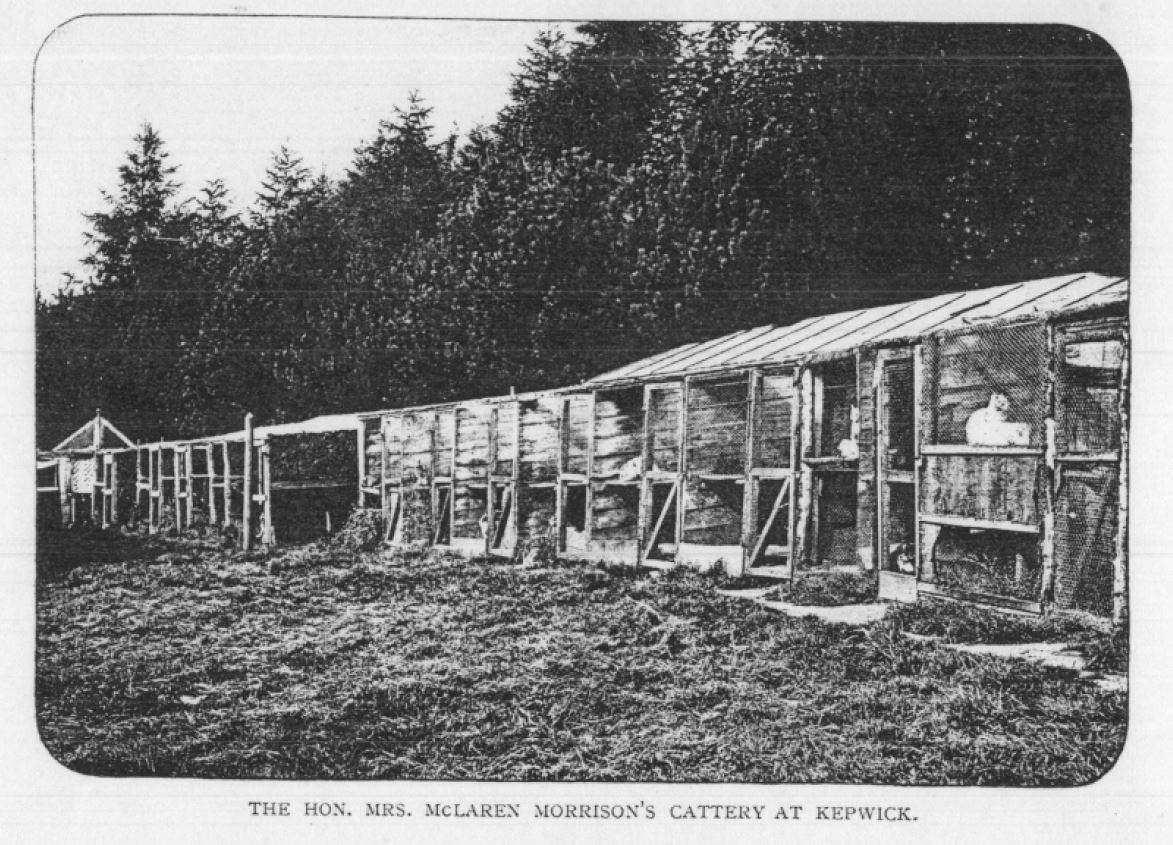
Mrs McLaren Morrison began exhibiting cats when she was Mrs H Warner. Compared to some of the catteries, hers appear a bit more ramshackle. She bred large numbers of cats and accounted for many of the registrations in early stud books and registries. She bred Persians, but she was an avid collector of imported cats and said in The Book of the Cat I love the imported cats, and always get them when I can. I have nine now at Kepwick. One of these hails from Patagonia and one from Afghanistan. My cattery at one time was twice again as full as now; but my losses have been great, and I have reduced the numbers so that I may give more attention to the young stock. This suggests her cattery tended to be overcrowded and suffered outbreaks of illness. Sadly she went on to become a cat hoarder.
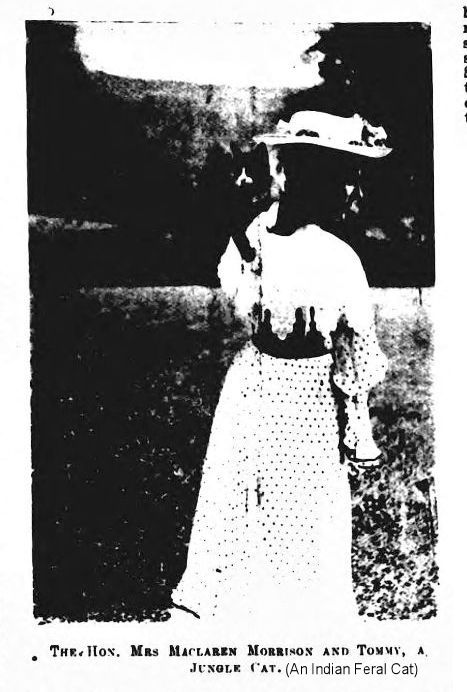
LESTOCK HOUSE MRS HERRING
Mrs. Herring s cattery was Lestock House, Lee, and she bred both long- and short-haired cats. At some of the larger shows she exhibited 25 to 30 cats and these arrived with Mrs Herring in a large omnibus or van. Her cattery sometimes housed as many as 40 cats, but in the late 1890s she had to reduce her stock due to complaints from her neighbours. This meant removing some excellent, well-arranged cat-houses that encroached on a neighbouring garden wall. Mrs Herring personally supervised her cattery rather than leaving it in the hands of staff.
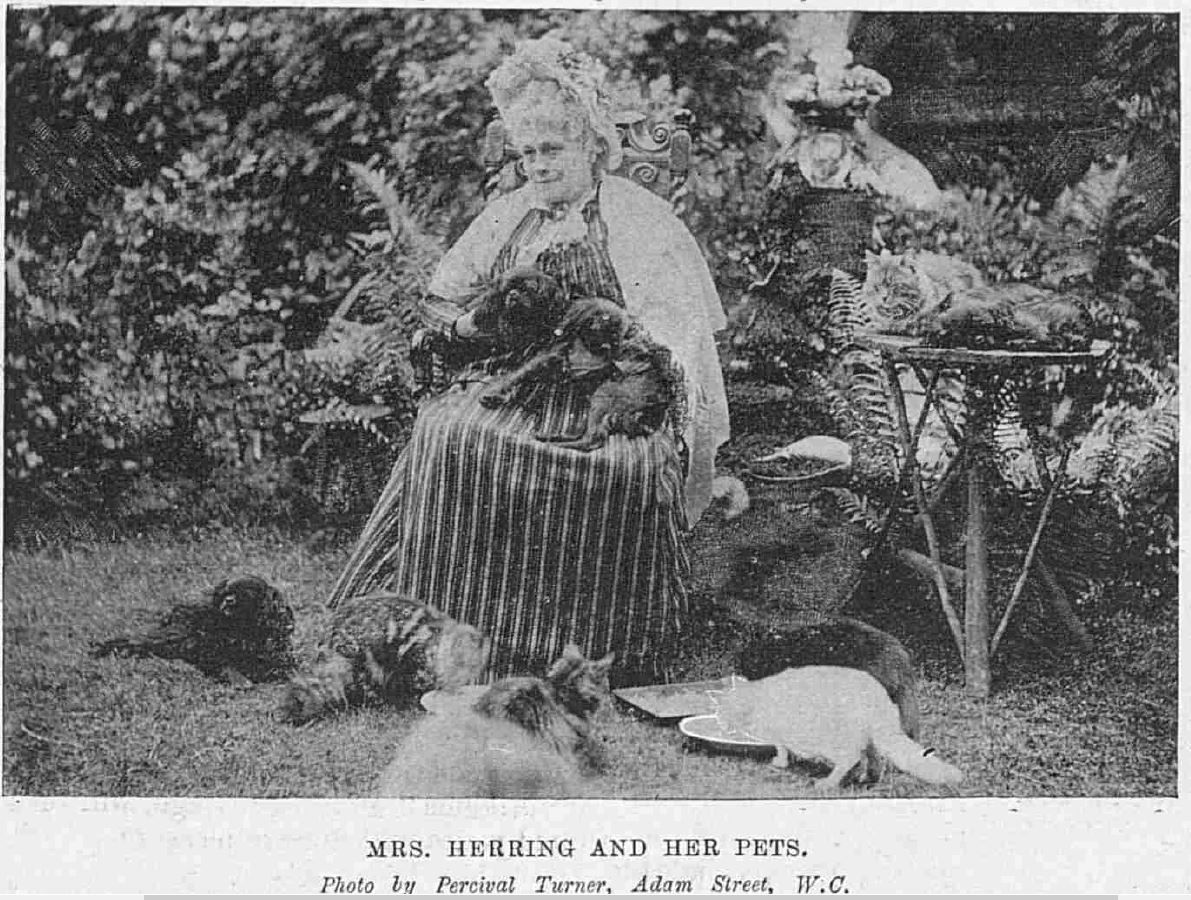
LOUTH MRS S.F. CLARKE
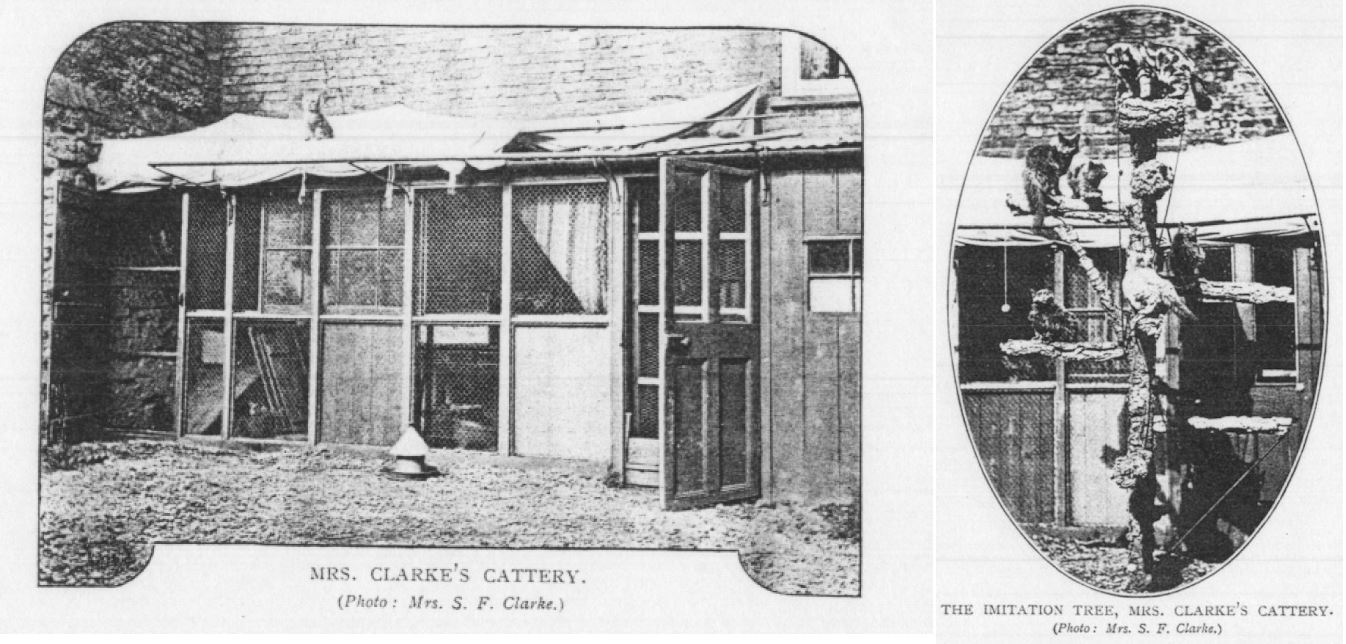
Mrs. S. F. Clarke bred Persian cats in limited space in her town residence at Louth. She had only a back yard 14 yards long by 6 yards wide so she had to be inventive in using this space. The area was fenced in, and an overhang prevented cats escaping or stray cats breaking in. The available cattery space was further reduced by her husband's laboratory building. A lean-to cattery and its covered run occupied a strip 7 yards by 2 yards, reducing the ground available for an exercise run to a patch 18 feet by 12 feet, plus a paved area of 21 feet by 6 feet. The space between the front of the laboratory and the paved area contained a small independent house and covered run used for isolation or for mothers and kittens. The covered run had shelves and an artificial climbing tree covered with cork. The open run was mostly gravelled (this required changing each year) with some grass strips. It also had an artificial climbing tree. Two smaller wired in run allowed cats to be separated if necessary. In this space she produced some excellent blue Persians.
MINLEY MANOR - MASTER CURRIE
MASTER CURRIE S CATTERY AT MINLEY The Queen, 8th June 1912
No cats have been more prominently before the public during the last four or five years than master Currie s beautiful white Persian who have been consistent prize winners whenever exhibited. The face and form of Mr Miles, kennel-man to Master Currie, is familiar at all the large shows, and to him the credit is due of penning the exhibits under his charge in faultless form.
On a lovely May day I visited Mrs Currie at Minley Manor and was taken over the new and up to date catteries situated amongst the pine trees of the beautiful park surrounding the house and gardens. Mr and Mrs Miles inhabit an old fashioned cottage close to the large field where the catteries have been lately erected. There is one large building painted green with lighter green sun blinds. In this there are four houses with runs and sleeping places about 18 ft. long. A large box full of shavings serves as the cat s bed and the run is laid down with fresh straw. There are plenty of shelves, so beloved of the feline tribe, and sloping wooden ladders. The windows face south and a broad expanse of meadow is in front with a background of pine trees. In the first house the lovely queen White Satin was sunning herself. The cat has several times been declared the best in the show, and she is a perfect specimen, grand in shape with a lovely head and bright blue eyes. White Satin is coming into nice coat and it is hoped she will be in try show form for Richmond on July 2. In the next house Puff Ball was enjoying an afternoon nap. This fine queen was purchased from Gertrude, lady Decies. Puff Ball s eyes are perfect in colour, and when in coat, as her name suggests, she is as broad as she is long. The quality of her fur is exquisite in texture.
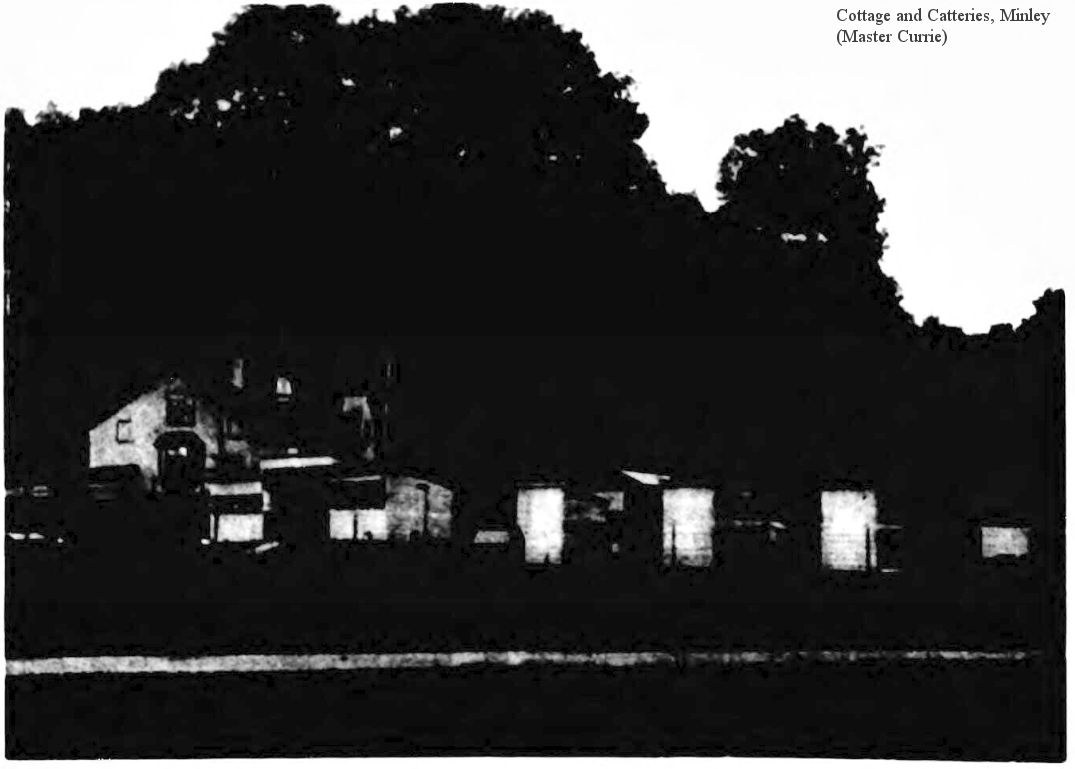
Crossing over the sort of ante-room where the food is prepared and the cats are groomed, two more houses are reached. Here The Rake [Minley Rake] was to be found, a promising young male fourteen months old exhibited at Westminster this year. He is an unusually fine and massive cat for a white Persian, and should make a grand stud for the Minley queens. The Rake is half-brother to the famous Romulus who died in the spring from pneumonia, so the youngster is doubly precious as Romulus was a very great pet with Mrs Currie and his death was a sever loss. Champion Minley Rex is well-known exhibit at cat shows, for he has swept the board several times, and his wealth of coat and marvellous show condition has been admired by all. Rex is two years old, but as yet has not sired any kittens. His father, Romulus, was three years old when he sired his first litter.
After leaving the large cat house I was taken to a series of small single houses, built in the same style, about 12ft. apart. Mrs Currie explained that in erecting these catteries she thought it would be a good plan to have some of the houses quite detached in case of illness after shows. In the first of these erections was Sea Queen, the mother of Rex, and at the present time she was looking after a litter of three kittens sired by Edelwald, Miss Kerswell s white stud. At first I saw one kitten, a lovely little male with a pair of light blue eyes, but presently the other two which were odd-eyed specimens were produced. This is a curious freak in white Persians even when both parents have blue eyes. I was assured that never before had odd-eyed kittens been seen at Minley. In the next detached house it was not a white, but a black Persian that was the occupant. Black Satin is the first of her variety to be an occupant of the Minley Cattery, and it is intended that only blacks and whites shall be bred on the estate. Black Satin has been mated with Copper Eyed Blackbird. This queen is cobby in shape with splendid orange eyes and nice small ears. It seems that this little black cat keeps all the whites in order, and has a particular aversion to her fair rival, White Satin. They are not allowed to meet now!
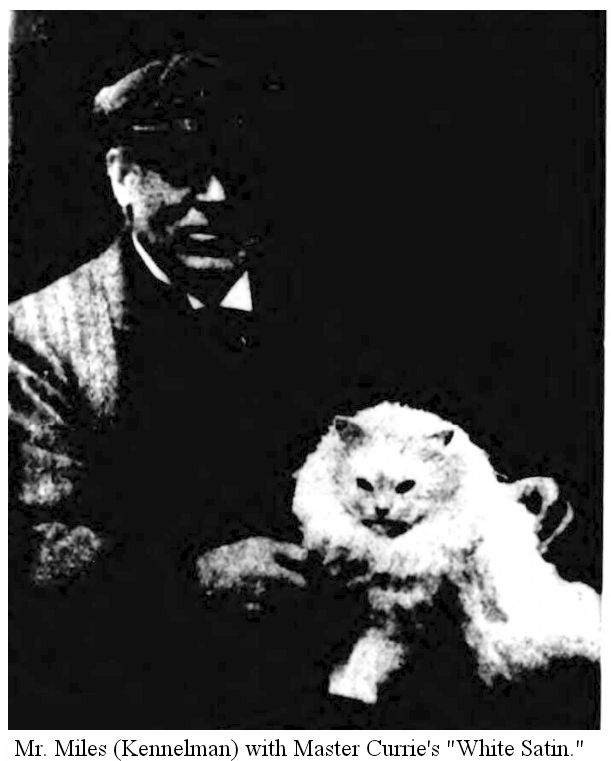
Every day the cats are let out for exercise in a very large wired in run, the males being perfectly friendly and taking their walks together. There are two delightful houses set apart for coming kittens. One of these is close up against the cottage so that the youngsters can be within easy reach of Mrs Miles who will superintend their bringing up. In two small houses I was shown some pale cream guinea pigs, Miss Daphne Currie s pets, and in an adjoining field a number of bantams were running about. Miss Currie goes in for this breed and has been very successful with them in the show pen. The Minley pigs have been distinguishing themselves recently at Newark and Oxford, all having returned with prizes. I must not forget to mention Mrs Currie s special pets who accompanied us round the garden. These are two blue Bedlingtons. Frances Simpson.
OAKLANDS CATTERY, BRIGHOUSE MISS CHEETHAM
MISS CHEETHAM S CATTERY AT OAKLANDS, BRIGHOUSE. The Queen, 28th February 1914
It was not the mewing of cats, but the barking of dogs that welcomed me to Oaklands on the occasion of my recent visit. So I will first mention Peggy Black, a well-bred Pekingnese, and Peggy Red, a nice Dachshund, the property of Miss Gladys and Miss Dorothy Cheetham. They have the run of the house and grounds and are on good terms with the inmates of the cattery, whose buildings occupy over an acre of ground. Some of these are transformed poultry sheds, others are new spacious houses with ample wired-in runs. In the midst of them is a rosary and beyond a kitchen and fruit garden. I introduced Blue Persians into England more than thirty years ago, and I can honestly say I never have seen a more beautiful collection of these cats. I was invited to accompany Miss Gladys Cheetham on her morning feeding round. She carried a large deep can of steaming cooked meat, and with a wooden spoon distributed it in the clean earthenware dishes placed ready in each cattery. [The rest of the report decribed the cats, not the cattery] FRANCES SIMPSON
THE REMENHAM CATTERY, HENLEY-ON-THAMES DR. AND MRS VLASTO
THE REMENHAM CATTERY, HENLEY-ON-THAMES. The Queen, 10th August 1912
Dr and Mrs Vlasto are enthusiastic lovers of animals, and at their beautiful home the hill above Henley they have plenty of space to indulge their fancy for dogs, cat,. and pigeons. On a glorious summer day I visited Remenham House. The garden was ablaze with flowers; there were rambler roses of every variety running riot over arches, summer houses, and pagodas. A troupe of Pekingese dogs followed us through the winding paths that led towards the cattery which has just been completed by Boulton and Paul. Dr Vlasto himself planned this ideal cats' home in a field adjoining the grounds, and every detail fur the comfort and welfare of the pussies has been carefully thought out.
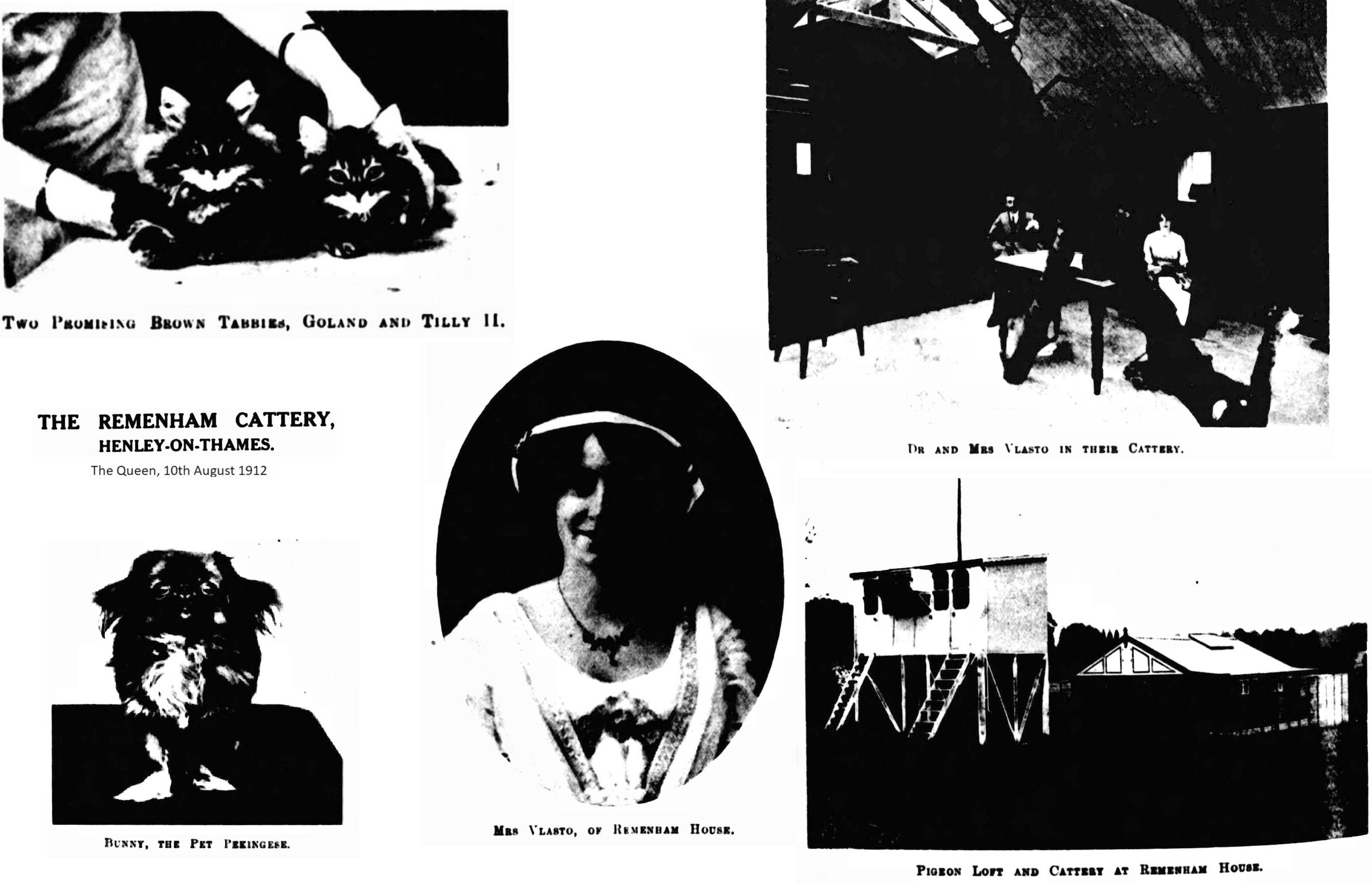
The whole structure is 16 feet square, with two grass runs of 20 feet. There are stud houses divided into day and night apartments with adjoining rooms for visiting queens. At the sides of the big square asphalted run are houses for cats with comfortable sleeping boxes well raised from the ground, and nice shelves so dear to the feline race as resting places. In the centre the quadrangle a slanting oak tree supported on a silver birch has been placed on which the cats can disport themselves and sharpen their claws to their hearts' content. At the back of the cattery there is a tool house cold ample accommodation for keeping dry earth. A sky light in the roof gives extra ventilation when needed. At the time of my visit, when a July sun was streaming down, the one thing needful seemed a green sunblind as a protection, not so much for the cats themselves, for they love to bask in the sun, but for their coat colour, which is easily affected, and often greatly bleached by the fierce light. As regards the inmates of these up-to-date catteries, I would mention that Dr and Mrs Vlasto have succumbed to the fascination of brown tabbies and go in now only for this somewhat neglected but delightful variety. One of the finest specimens at Remenham is Betty, a brown tabby queen, that may be called a pick up, for she was purchased for a few shillings from a cottager who wished to get rid of her. This queen is grand in markings and colour, and great things are expected of her offspring. Another grand specimen is Wuzzer, a fine big burly cat purchased from Mrs Drury, who made a name for herself by breeding and exhibiting many excellent "brownies." Wuzzer is of Persimmon breeding and has been mated to Brown Bruno of the same noted strain. The result is anxiously awaited. Dimity is another of Mrs Drury s cats, and she is in kitten to Mr Powell s well-known prize winner champion Invincible. Flirt, another queen, with a grand head, and bred from Persimmon on both sides, has been sent further afield and has visited Mrs Slingsby s cattery at Thorpe. She is mated to champion Viking, formerly the property of Miss Whitney, and one of the best known brown tabbies in the fancy. And now to refer to the junior members of the cattery.
In one house Sally Sun s daughter was in hospital, having an abscess, which, alas! may prove fatal. She is sister to the brown tabby male owned by Mr Powell, which made such a sensational debut at the recent Richmond Show, Brown Bruno being the sire of this lovely specimen, and also of a delightful little kitten which was dancing about in the playground. Tilly H. was bred by Mrs Bird, a great brown tabby enthusiast, and doubtless a future is in store for this specimen, with her gorgeous dark markings and tawny ground colour. A remarkable kitten, Goland, having one of the Brayfort cats for its sire, was at birth a pale silvery lavender with no markings. It is now about twelve weeks old, and the head and face are turning a lovely rich brown with distinctly dark tabby stripes. The legs ar showing signs of bars, and well the silver body fur is blown apart tabby markings of correct colour are to be seen. This kitten might be called the Remenham Problem, but he goes by the pet name of Golly. I must not forget to mention the cosy little catteries nearer the house which are called the nurseries. Here Daisy, a brown queen, was mothering a family of three kittens by Brown Bruno. They were too small to pass an opinion upon, but seemed a fine, healthy trio. On an adjoining house a black Pekingese was looking after her three puppies. Mrs Vlasto has bred some nice specimens of this fashionable variety. At the present time the spoilt pet of the home is Bunny, a tiny toy Pekingese weighing under 3-and-a-quarter lb. at eleven mons kennel name, Me-soh-wee. There are in all seven dogs at Remenham in splendid form and revelling in the freedom permitted them in their lovely country home.
Dr Vlasto is a keen pigeon racer, and has some fine birds. There was excitement at Remenham on the occasion of my visit, for it was the eve of the Bordeaux and Dax races, and as Dr Vlasto came out very well in these races last year, he was hoping to do better this; but alas! a fog in the Channel proved disastrous to the pigeons.
FRANCES SIMPSON
ROMALDKIRK CATTERY MISS BEAL
Miss Beal bred some noted cream Persians. The cold climate of the Romaldkirk cattery, situated 730 feet above the sea level, seemed to suit that variety of Persian. Most of the houses were old farm buildings around a stable yard, and also an old granary above the coachhouse. The cattery was about 40 feet long, and had a room at one end, with five windows and good ventilation above. In addition there were three big cat houses and a loft, where most of the queens resided. For the males, there were small wooden houses, felted inside and out, with wired runs and concrete floors. For sick cats that needed warmth, she used her two laundries and a tool-house fitted with fireplaces.
SEAGATE HOUSE MRS MACKENZIE STEWART
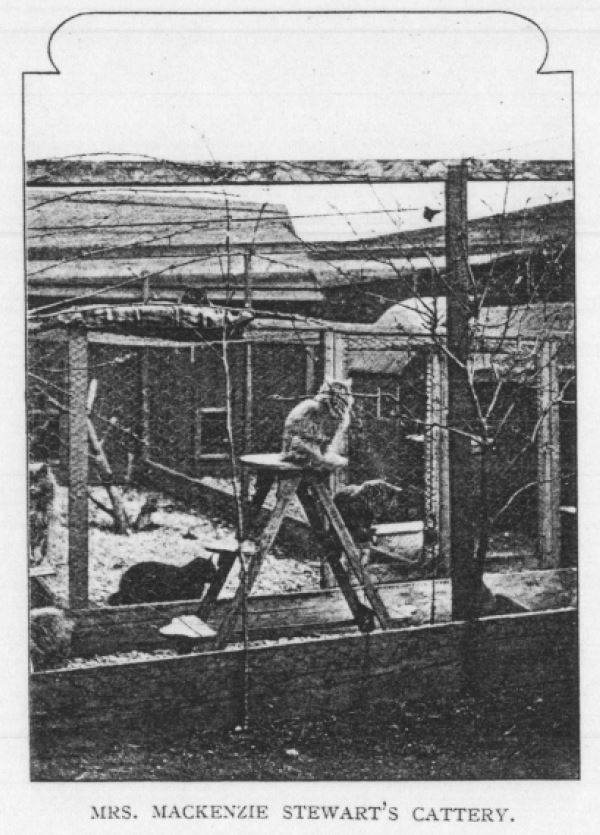
"One of the largest catteries in Scotland, where the fancy grows apace, is owned by Mrs Mackenzie Stewart, of Seagate House, Irvine. Mrs Stewart has possessed several notable cats of different breeds. Her blue stud cat "Ronald" has made himself a name in the south of England as well as in the north. Mrs Stewart has had silvers, creams, brown tabbies, and is now the owner of the celebrated black stud cat "Dick Fawe," who has sired many winning kittens. The severe weather of this part of Scotland seems to suit these Persian cats, for a healthier, hardier set of pussies one could not wish to see than those disporting themselves in the pleasantly situated catteries of Seagate House. Mrs Mackenzie Stewart is a most enthusiastic fancier, and often takes the long journey down South to bring her pets to the London shows. She has acted as judge in Scotland and England, and a contingent from the Seagate cattery is generally to be seen and admired at most of our large shows." - Frances Simpson
SWALLOWCLIFFE MRS HARDY
MRS PAUL HARDY S CATTERY - The Queen, 24th October 1908
IN THE MIDST OF BEAUTIFUL SCENERY of woodland, vale, and hill Mr and Mrs Paul Hardy have their home. The Mill House, Swallowcliffe, is situated about fifteen miles from Salisbury, and is a fitting dwelling place for two such beauty loving people, Mr Paul Hardy being well known for his clever black and white work, while Mrs Paul Hardy has modelled Florizel, one of the King's horses. She has also frequently exhibited her work at the Royal Academy. A portion of the quaint old Mill House dates back to 1600, and about seven years ago, when Mr and Mrs Hardy discovered this old place, they set to work to plan and to restore. The present beautiful oak-beamed drawing-room was the shed in which the mill was fixed, and just outside the window is the bubbling stream which worked it, while the lawn beyond was formerly the mill pond. It is now a lovely flower garden, where rose trees flourish. The stable near at hand was turned into a studio for Mr Hardy, and the cow and cart shed into an ideal cattery for Mrs Hardy's blue Persians. Truly, the former owner of the Mill House would fail to recognise his old home after its transformation in these artists' hands.
Although late summer when I visited Swallowcliffe, there were flowers everywhere, both indoors and climbing over the quaint old building out of doors. Mrs Hardy, besides being a modeller and cat fancier, is a clever gardener, it being wonderful how she finds time to carry on all her hobbies. It was in 1897 that this lady first exhibited blue Persians at the Crystal Palace, and I recollect the litter of kittens which won a first prize for their delighted owner. Three afterwards became famous, their names being Mark Anthony, Nino, and Tony. The first named is still a valued stud cat in Scotland, and Nino won several prizes for Lady Maitland. From this time forward Mrs Hardy has been faithful to blues, and in 1907 her blue male Bonnie Marcello carried all before him at the Westminster Show. He is now residing at the Mill House in a fine cattery, with a wired-in grass run 30 feet long, and his kittens have done credit to their sire, having won many prizes.
A fine blue female called Lucy was given to Mrs Hardy by Mrs Slingsby, mid mated to that lady's well-known Zeus. A litter of blues was the result; but Lucy, being deficient in maternal instinct, refused to attend to her offspring, so a foster-mother was in readiness, and is nursing the family. This short-haired cat was at the time of my visit doing her duty in the most exemplary manner to the five strangers who had suddenly replaced her own variegated little family. Two exquisite young cats with lovely heads and nice orange eyes were the remnants of a fine litter of six by Neila Billi, Mrs Slingsby's renowned stud cat. Mrs Paul Hardy was taking a well-earned holiday when this family was about two months old, and her over-anxious cook, in the kindness of her heart, became too lavish in the feeding of the youngsters. A sort of typhoid fever was the result, and the kittens went down like ninepins. Mrs Hardy has a great affection for the two which she saved, and is still carefully dieting. They should make a lovely pair to exhibit at some of the cat shows this winter.
A fine young blue male lives on the best of terms with Bonnie Marcello. He is by one of Mrs Hardy's former stud cats, Cerulean, and a San Toy queen. Apart front the blues, Mrs Hardy has a dear old silver neuter eat, called Pharaoh, a son of Cambyses, who is the house pet, and an orange and white female with a sweet face came as a present from Mrs Slingsby, who owns her mother, the well-known champion Rosette. Mrs Hardy is a great believer in fish and fowl as a food for cats, and certainly her animals are a flourishing lot. The Swallowcliffe cattery has the advantage of having an owner who is not only an enthusiastic fancier, but also a keen animal lover and an indefatigable worker. FRANCES SIMPSON
SWINTON GRANGE - THE HON. MRS CLIVE BEHRENS
THE HON. MRS CLIVE BEHRENS AND HER PETS - The Queen, 17th November, 1906
By Frances Simpson. A lover of animals all her life, Mrs Clive Behrens has, however, only recently taken up Persian cats with a view to breeding and exhibiting them; but a visitor to Swinton Grange cannot help being struck with the feeling that animals hold a foremost position in the affections of both Capt. and Mrs Behrens and their two little children, and that the beautiful home would be incomplete without the dumb creatures which seem part of Swinton Grange. To an onlooker the most favoured pets would appear to be Vixen, the broken-haired fox terrier, who is a regular rogue, and the young white Persian male, who was a short time back in seriously bad health for many weeks. Capt. Behrens, however, declares that the cats come first with Mrs Behrens, just as the breeding of shorthorned cattle is his favourite hobby. It should be mentioned that, a collie named Fan was the first to greet me on my arrival, and as I sat laid her pretty pointed head on my lap; but I was assured that it was cupboard love which caused her to be extra affectionate at the tea hour.
Like most cat fanciers, Mrs Behrens has this year experienced severe reverses in rearing Persian kittens. The great heat of the summer and the rapid changes of temperature from one day to another have proved very trying, especially to highly bred Persian cats and kittens, and I heard, therefore, with much regret of some beautiful creatures who had succumbed to mysterious illnesses. However, the handsome white Seafoam had been brought triumphantly through a severe attack by his devoted mistress, and he appeared in excellent health and spirits. There was no hesitation in the way in which he cleared up his breakfast.
In a large room at the top of the house a pretty sight met my eyes, for domiciled here were three mothers and a foster with their various families. Round the spacious apartment wooden boxes were arranged at intervals as sleeping places, and contained a litter of brown tabbies of good shape and fair colour, three beautiful blues and some charming white kittens, all bred from Mrs Behrens's own stud cats. I was particularly struck with a grand-headed blue queen, which was nursing a promising blue male kitten. Lisabel is one of Mrs Slingsby's famous strain, and owns Gervase of Thorpe as her sire. She has already won prizes, and should have a show career before her. Another good blue female, called Nina, had two pretty blue kittens, and a fine white queen seemed proud of her three snowballs.
Mrs Behrens's outside catteries, not far from the house, are in a delightful situation, facing south, with long wired-in grass runs. Here I was introduced to a fine blue-eyed white male, Pierrot by name, who was in good coat and condition, end might be described as in rude health. He is bred from Peerless Pearl a well-known winning queen, and the blue-eyed Wanderer, who has made a name for himself in the fancy. In a neighbouring cat house of spacious dimensions were four inmates. Of these I will first mention Columbine, a perfect little white female of about seven months. She is by an imported mother and Boynton Grip, and I may mention that the last named was recently sold for a high figure to go to America. Columbine has clear, bright blue eyes set in a round head, carries a beautiful, long, thick coat, and is perfect in shape. She ought to achieve success if exhibited at some of the coming winter shows.
A young cream male was one of her companions. Sandy Dandy is half-brother to Mr Helmer's noted winner; his eyes are deep amber, and when he gets into coat he should be a handsome fellow. A little blue queen, good in all points, save eyes, and a pretty brown tabby queen made up the number in this comfortable cattery. All the inmates seemed in good health, and do great credit to their mistress's care and feeding. Mrs Belvens herself personally looks after all her cats, and seems to find nothing a trouble which concerns their welfare. Her special favourites are blue-eyed whites and orange-eyed blues, and she intends to keep to the breeding of these varieties.
In the stableyard a fine collie chained in a kennel, and when let loose Tramp bounded forward for a scamper the grounds; he occasionally finds his way into the house. In the harness-room I observed a black shorthaired cat warming herself by the fire, and what had been a white puss well inside the fender. Truly these two animals had fallen on their feet for they were strays which, with much discretion, had discovered a happy home. In the well-appointed stables were six or seven hunters, and ready harnessed to start forth for Melton stood Hash, the pony, a great pet of Mrs Behrens's. In a secluded corner of the garden under some tall pine trees several pets are buried, the large mounds covering two favourite horses, and the little white headstones tell the story in verse and prose of the pussies that are beneath.
THORPE UNDERWOOD CATTERY - MRS SLINGSBY
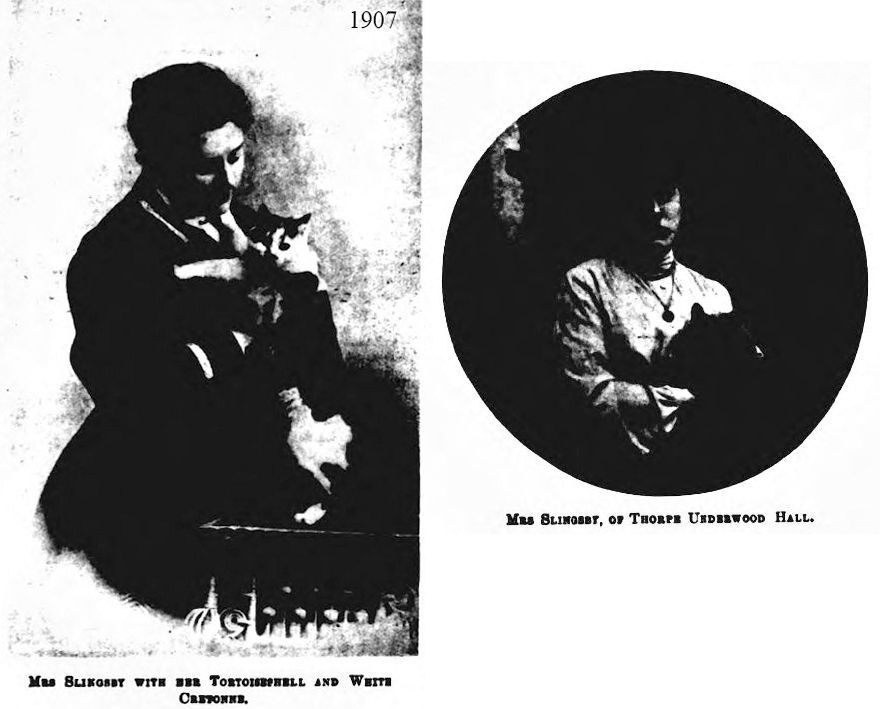
MRS SLINGSBY'S CATS AT THORPE UNDERWOOD HALL. - The Queen, 6th April 1907
This name is one to conjure with in the cat fancy, for during the last six years, no one has been more to the front at leading shows than this enthusiastic fancier. Perhaps the most noticeable feature regarding the Thorpe Underwood exhibits has been the faultless condition in which they have always been penned, while all the cats have that well groomed appearance which generally obtains for them a high place in the prize lists. Mrs Slingsby Is a keen sportswoman and rider to hounds, and my visit to Thorpe Underwood being made in the middle of the hunting season my hostess received me in her riding habit, as she had just returned from a hard run.
Mrs Slingsby is a true fancier in every sense of the word. Taking the rough with the smooth, and in spite of many reverses of fortune in her large cattery, she never loses heart, but cheerfully makes a fresh start if the need should arise. Last season, for instance, she experienced several losses and much illness amongst her litters of kittens, while this year she herself has had to battle against an attack of influenza, which prevented her from exhibiting at Harrogate and Staines, though she had made a number of entries at each show, hoping to have accompanied her contingent of well-known winners and bring out some promising novices. Happily, however, there is now only good news from Thorpe Underwood of both mistress and pets. The Hall is a fine new house, built on the site of an old mansion which was partially burnt down. Some of the buildings, however, are still left, and two or three of the rooms have been converted into delightful habitations for the female cats and their kittens. One room is fitted up as a kitchen, a corner of which is set apart as a dispensary and fitted up with every requisite, including a tooth scraper and dental forceps.
I wish I had possessed a camera on the occasion of my visit to take a snapshot of Mrs Slingsby in her large linen apron preparing a meal for her numerous pets, for this lady fancier not only superintends the feeding of her animals, but works with a right good will. Nothing seems to escape her, and nothing appears too much trouble where the welfare of her cats is concerned. Seeing her as I did in the bitter cold weather and in drenching rain going to and from the cat kitchen to the stud houses, &c., I was not surprised to hear of chills and breakdowns in health. To give but one instance, it may be mentioned that a little camp bedstead stood in one of the rooms where the females were disporting themselves, and on inquiry I learnt that this was kept aired and ready for use in case any of the cats fell ill, when their devoted mistress would take up her quarters for the night in this apartment.
At the time of my visit no less than nine blue Persian queens were running in and out of these rooms. I specially noticed their wonderfully massive heads, and some were possessed of gorgeous orange eyes, while my attention was drawn to Nita, rather an elderly-looking puss, who is a sort of foundation-stone of the blue section of the Thorpe Underwood cattery. She was mated to Darius I., and the first fruits of this cross was the noted champion Orange Blossom, who was exhibited at Manchester in 1901, and later became a celebrated winner and sire. This fine blue died about two years ago, to the great grief of his devoted mistress.
Although blue Persians may be considered Mrs Slingsby s speciality, yet she is now patronising other varieties. There were two black females, one by the noted Dick Fawe; two brown tabbies, daughters of Fina and Orange Blossom; and tortoiseshell and white (daughter of Mr Wood's Minette), Rosette by name, a grandly patched and bright coloured specimen of this charming breed. I hear, too, of recent additions to the ranks, for Mrs Slingsby has purchased Mahitabel of the Durhams and her sister Glory, which queens are superb in colour and almost self orange. This lady has also secured the noted winning cream Calliope II., while one or two silver tabbies and a few good short-haired females must not be forgotten; and Cretonne, the short-haired tortoiseshell and white, has been declared the best in the fancy; she is grand in colour, very evenly patched on the head and ears, with nice round head and brilliant orange eyes.
And now to refer to the splendid team of stud cats, which are the pride of their owner and the chief glory of the cattery. A long row of neatly arranged wooden and brick houses, not far from the buildings before mentioned, are inhabited by about a dozen superb cats, and the quartet of blue male Persians are well known in the fancy. Neila Billi was purchased from Mrs W. R. Wyndham, who as a novice exhibited him three years ago at the Crystal Palace, and was greatly surprised and delighted at winning many prizes and specials, together with the medal offered for the best cat in the show. Neila Billi has been winning ever since. The three other blue males are Zeus, Bertrand, and Gervais, all grand cats of rather different types. Perhaps the chief charm of these blues is the soundness of colour, and it should be added that they are in superb health and condition. The name of Don Pedro is one of fame in the cat world, for he has won whenever shown, and, though getting on in years, is in superb form, while as a silver tabby he is hard to beat with his dense markings and pure undercoat. Mrs Slingsby has bred some beautiful kittens from him, one being lately shown at Cheltenham. At the time of my visit there were two promising young chinchilla males by Rob Roy, of whom their mistress was hoping great things, but silvers are tricky, and one never knows whether they will ultimately turn out pale or shaded. Mrs Slingsby wisely places some of her cats and kittens out in surrounding cottages so as not to have too many gathered together in a limited space; thus, Peggy, a blue with a litter of kittens, was being taken care of at a cottage on the estate, and Don Pedro's son was under the charge of the keeper's wife. I noticed a blue who seemed all over the place, playing with the females, following his mistress, and generally enjoying his freedom. This, I was told, was Mist, the clown of the cattery, but he is shortly to be removed.
Mrs Slingsby made her debut as a judge at the cat show at Harrogate in when she generously bore the expenses of the show, gave numerous specials, and guaranteed several classes; but, indeed, this enthusiastic fancier is ever ready to extend a helping hand at the various cat shows, and is at all times a generous giver, while there are not many exhibitors in the cat fancy who can boast of such a fine collection of prizes, badges, medals, and cups as are to be seen in the morning room of Thorpe Underwood Hall. - FRANCIS SIMPSON.
WOODHEYS GRANGE MRS G.H. WALKER
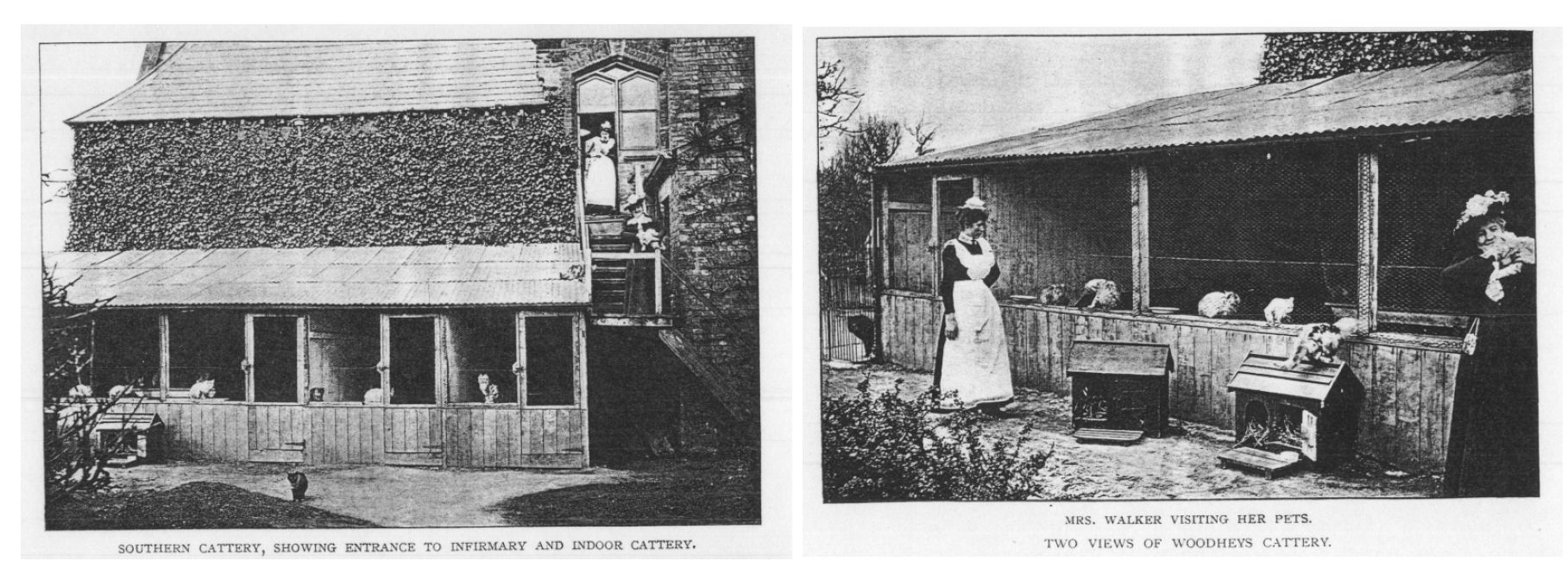
Mrs. G. H. Walke had an excellently planned cattery at Woodheys Grange, Woodheys Park. The floors of the outside catteries, which face south, were cemented, so that they could be washed over every day. The roofs were boarded, and then covered with galvanised iron, so that the rain ran away easily. The spacious apartments were fitted with benches and ledges, and trunks of trees and leafy shrubs were planted in the ground for the cats' special amusement and exercise. The kennels were placed outside for photographs, but were normally inside and provided cosy sleeping dens. There was a maid in attendance and the kennel man also helped.
A staircase led to three upstairs rooms or apartments. In one, all the appliances and utensils connected with the animals were kept. In the second, were mothers and kittens until they were old enough to go outdoors. In the third was the isolation ward for sick cats. In one of the loose boxes near at hand, the cats meals were cooked, and there was a larder especially for the cats' food. Despite the well-arranged premises, one of her cats returned from a show and spread infection which killed off many of her cats. The cattery normally housed around thirty cats, but had contained as many as sixty-three in the heyday of silver Persians.
WERNHAM CATTERY MRS NEATE
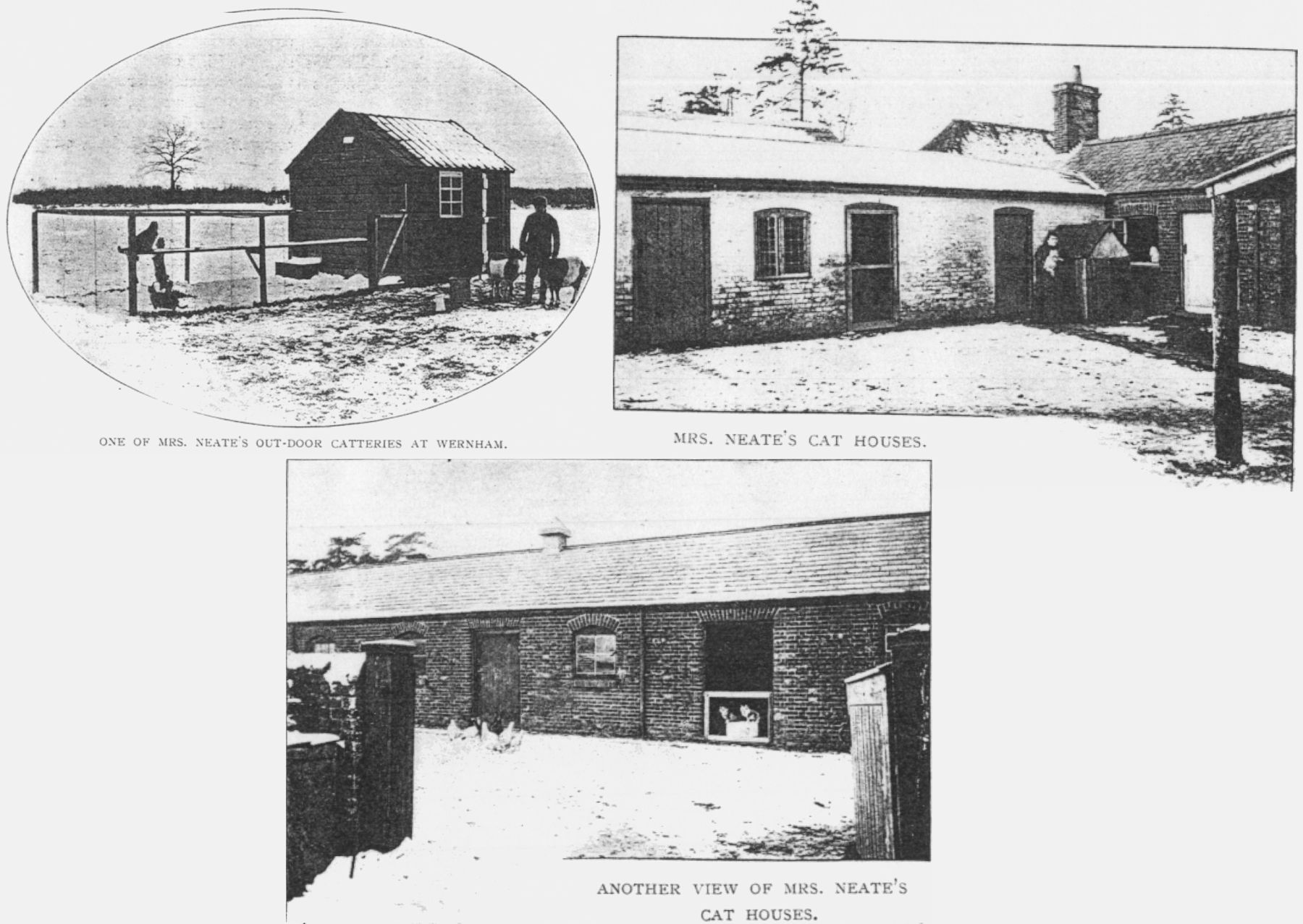
Mrs. Neate specialised in Orange (red) Persians. In the 1890s, she reduced her own stock of breeding queens, and made a speciality of boarding other fanciers cats during the holidays. Mrs. Neate gave personal supervision to her boarders as well as having splendid custodians in the form of a St. Bernard and a chow-chow. The dogs were on good terms with the cats. The photographs were taken in the depth of winter and show brick-built houses, slate roofed, wire doored and wooden floored. These were originally outhouses and were adapted to the cats snug and warm during the cold weather. The largest of the outhouses is fitted with a Tortoise stove, carefully guarded. One of the buildings illustrated was 25 feet by 15 feet, and has three windows. It was equipped with a large table, shelves, and chairs, and cosy sleeping-boxes. An outside wire run, of the same length and width as the building, was erected for an exercise ground in summer weather.
Wernham, near Marlborough, was in the heart of the countryside and a mile from any other house. This meant her cats could safely enjoy their liberty. A herd of pure-bred goats supplied the inmates of the cattery with milk. The area abounded with rabbits, and these formed their staple food when in season. A number of portable houses and runs were dotted about the kitchen garden and meadows. An empty cottage served as an isolation hospital and also for quarantining cats returning from shows until it was certain they hadn t brought home any infection.
WROTHAM PARK CATTERY - LADY RACHEL BYNG
NOTABLE CATTERIES THE WROTHAM PARK CATTERY.The Queen, 17th February 1906
LADY RACHEL BYNG is well known in the cat fancy as an enthusiastic breeder and admirer of blue Persian cats. The Countess of Strafford, mother to Lady Rachel, was appointed president of the National Cat Club in 1904, when the Duchess of Bedford, who had held that post for many years, resigned. At a recent N.C.C. meeting the Counters of Strafford presided. Lady Rachel Byng is one of the vice-presidents of the Blue Persian cat Society and has been member of the club since its formation in 1901. A short time ago Lady Rachel was afraid she would be obliged to abandon her hobby and all her famous blue Persian cats and kittens were advertised for sale. Circumstances, however, arose which enabled her to alter her decision and to keep her pussies, and, if anything, she is going in" stronger than ever for the fancy.
Wrotham Park, the residence of the Earl of Strafford, is within easy reach of London, being situated midway between Potters Bar and Barnet stations, on the Great Northern Railway. Here, in the beautiful park which surrounds the fine ancestral home, Lady Rachel has quite lately had some of the most delightful catteries erected, adjoining one of the cottages on the estate. The inmates of the cottage take the greatest interest in the "blues," and, to judge from the appearance of the cats under their charge, they must receive every care and attention. It was a glorious morning when I journeyed down from town to visit the Wrotham Cattery, and it was a real pleasure to walk through the beautiful grounds, where spreading cedar trees lent a charming variety to what appeared an endless expanse of hill and dale. The cattery cottage is close to the Great North Road, about ten minutes' walk from the house. Here, in full view of the passers-by, the cats disport themselves in their spacious wired-in runs. Cyclists often stop and stare in amazement at the grey-blue creatures climbing up the cages, and inquiries have been made as to what sort of animal these were whether monkeys or cats! To guard against any desire for appropriation on the part of wayside admirers Lady Rachel has insured her valuable cats at Lloyd's.
The catteries are 20 feet by 12, and in each run there is a comfortable wooden house, with sleeping boxes well raised from the ground. Then at some distance from the three cats' homes there is another smaller cat house, which is specially adapted for a hospital. In the first cattery were three fine blue queens, two of which might well have been mistaken for males, as they were unusually large, with grand heads. There was also a neat-looking short-haired female, which Lady Rachel informed me was the useful foster mother, whose services had sometimes been found requisite. The aristocratic blue ladies at first resented the presence of this common or garden cat, but she is now tolerated in their midst. The three blues, named Bluebell, Blue Girl, and Beauty, were in grand coat. Bluebell is a daughter of the well-known stud cat Goliath II. Blue Girl is by Darius I. A very fine-shaped queen, Beauty, is a grand-daughter of the celebrated Moko. So that Lady Rachel has some fine stock from which to breed future prize winners.
In the adjoining run were five kittens of Beauty's last litter, by Robert of Cademuir, son of Blue Boy II. There were eight kittens in this litter, and six of these lived and flourished. Two were unfortunately overlaid [mother lay on them]; one had been sold before my visit. The three females made a bonnie trio, and I bespoke the smallest, Pathos by name, who has the lovely deep orange eyes for which her father carried off several special prizes. The two males were in another run, looking the picture of health and strength, and carrying enormous coats . Pluck, commonly called The Fat Boy, had very fine orange eyes. He is now the only remaining kitten of this large litter, the rest having been sold at good prices.
At the time of my visit the stud cats' house was standing empty, for Lady Rachel sustained a very great loss by Brushwood Boy's death a few months ago. This fine big blue was well known on the show bench, and he had sired many winning kittens. He was also a most lovable put. Ever since his loss Lady Rachel has been trying to obtain a worthy descendant to fill his place. It is a great satisfaction that at last she has succeeded in securing a grandson of her old favourite, and Wrotham Giant is now advertised at stud in the columns of the cat papers. Yet another addition has been quite recently made to the trio of blue queens, as Lady Rachel has purchased Diana, a daughter of Brushwood Boy. These two newcomers have fine heads are level in colour, and have good round yellow eyes. Lady Rachel has not always been faithful to blues, as but a short time ago she possessed a handsome silver stud cat called Pathan, which she exported to America, where he is making a name for himself.
At the Barnet Children's Hospital one of the Wrotham blues is the beloved pet of the little invalids, and helps to enliven the weariness of many a suffering inmate. There are no cats in the stately home of the Straffords, the only indoor pet being a Scotch terrier, that appeared to have his own way in everything and with everybody. I would fain have lingered to study the superb pictures by Vandyke, Murillo, Titian, and Velasquez that adorned the walls of this noble mansion, but I had to hasten back to town, and could only give hurried glances at the many treasures that happily were saved to the Straffords when, some twenty years ago, the interior of the house was entirely burnt out, leaving only the walls standing. I had hoped to give some good illustrations of the Wrotham cats, but Lady Rachel writes: "I enclose the best photographs I have been able to take of the naughty kittens. Blue Giant absolutely refused to sit for his portrait, and insisted on turning his head away at every moment." I must therefore leave the beauties of the Wrotham blues to the imagination of my readers, for it is more than probable that none of the photographs will be found suitable for reproduction. Frances Simpson.
MISS DERBY HYDE
A MODERN CATTERY - Preston Herald, 1st April 1899
In any hints here given as to the formation of a working cattery, due attention is, of course, paid to the ever-important subject of economy. Fanciers seldom wish to spend large sums on their hobby; indeed, most of us have to spend quite enough in keeping our money-making amusements" going, so that we are usually unwilling to dip very deeply into our pockets at the start. Of course there are exceptions to the rule, and some of the crack kennels are just as beautifully finished and well fitted as the home of a racing stud, which is certainly saying a good deal. It is seldom, however, that one thinks of cats being treated with such liberality, yet such is occasionally the case, at all events if one may judge by the account of a certain famous cat-house recently noticed by the Stock-keeper." Miss Derby Hyde is a well-known cat enthusiast who has at present close on thirty of her favourite race, including amongst the number Persians (surely the loveliest of the whole race), English (a variety which is receiving far more attention than outsiders are aware of), and, course; Siamese, those quaint cats which are now highly valued, and which never fail to attract so many admirers whenever and wherever shown.
For such a large family Miss Hyde naturally requires fitting accommodation, and who shall say that this fancier does not do her favourites remarkably well? The cat-house stands in the garden, but is connected with the house by a long glass-roofed corridor, so that their owner can visit her favourites in all weathers. The cattery has a central hall, with chairs, baskets, and rugs placed round the stove. On the right a corridor runs south, having on each side cat rooms or pens, with proper benches and half-wired doors, so that the inmates get plenty of fresh air and light, and can enjoy each other s company. Each room has a separate window, which is in itself a great advantage. Of course one room is devoted entirely to the kittens, which certainly should well in such ideal quarters. When actually completed, there is to be a second corridor on the same lines. The above is interesting not merely as an example of what fanciers will do for the good of their pets, but also because much may learned from the way in which this experienced fancier has set to work. That the house is warm and snug as house can be there is no doubt, yet clearly Miss Hyde understands the value of light and fresh air. Without dwelling on that oft-discussed subject, we are yet glad to once again draw attention to it, believing that there is no topic of more importance if amateurs wish to hove healthy stock or to conquer disease.
MRS HAWKINS
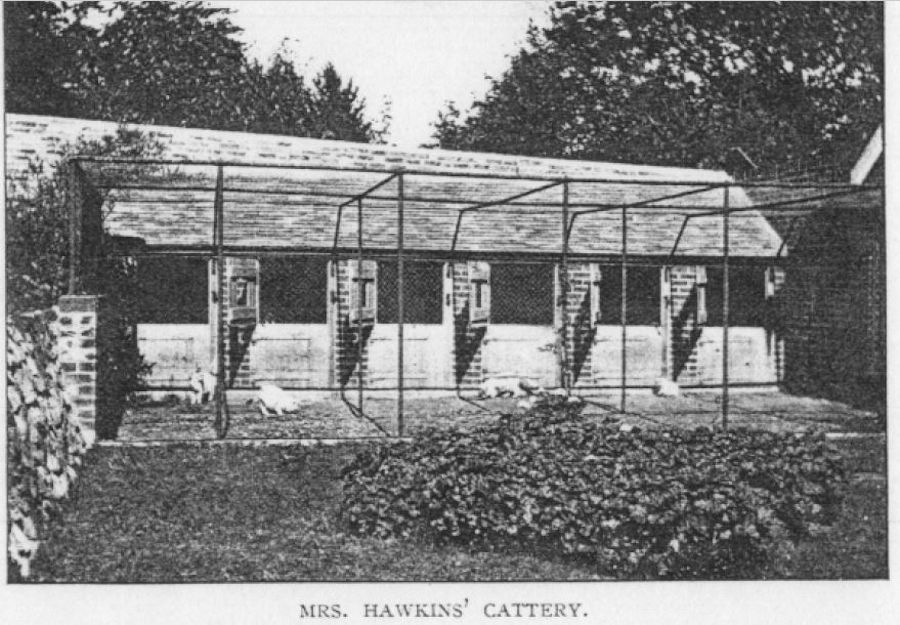
Mrs Hawkins bred Siamese cats.
MRS WELLS
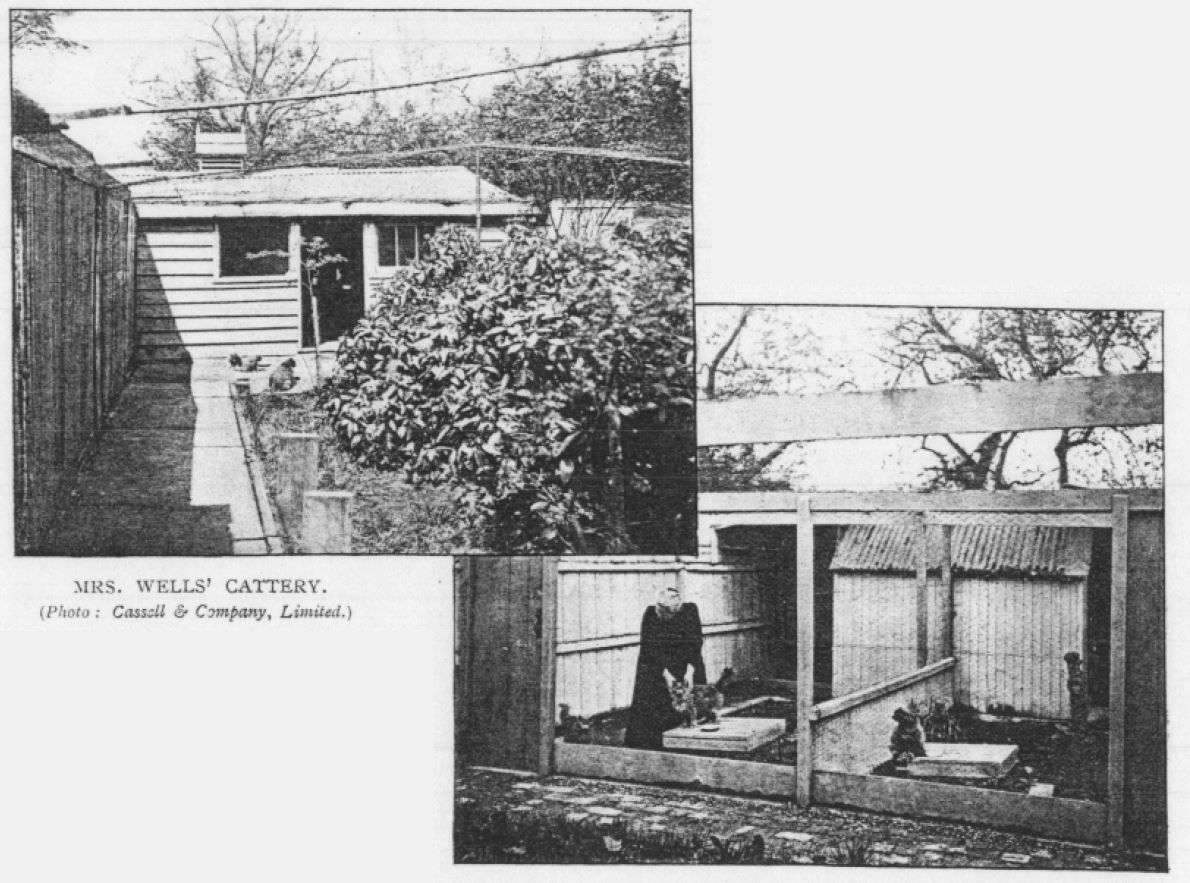
Mrs Wells, of Isleworth, was one of the first exhibitors of blue Persians She had well-planned catteries with plenty of space and large wired-in runs, planted with shrubs and plenty of grass. Her cottage was situated in a most rural district of Isleworth.
SEYMOUR LODGE & CUMBERLAND LODGE - PRINCESS VICTORIA OF SCHLESWIG-HOLSTEIN
PRINCESS VICTORIA OF SCHLESWIG-HOLSTEIN - abridged from The Washington Post, May 12, 1907
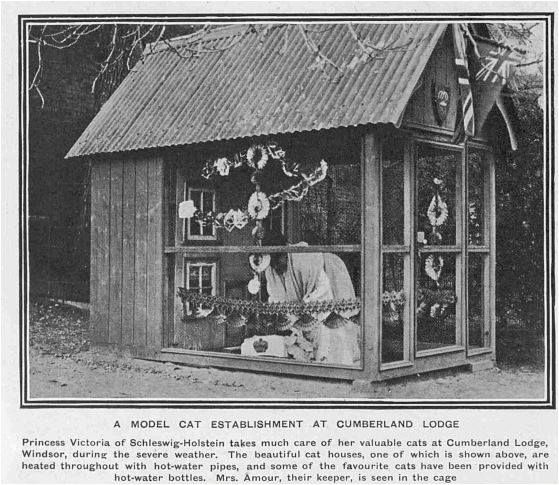
Princess Victoria Of Schleswig-Holstein is the acknowledged leader of the cat cult" In England. Father Bernard Vaughan may or may not have been aware of this fact when he fulminated so violently against the cat and dog worshipers of society. It is doubtful, however, if even the Mayfair Savonarola could convince her highness that she is imperiling her immortal soul by lavishing her affections on cats. At Cumberland Lodge, in the royal domain of Windsor, where she resides with her parents, Prince and Princess Christian, she maintains a veritable feline paradise, where her furry pets revel in luxurious idleness, relieved of all the obligations imposed on common pussies of earning their board and lodging by catching rats and mice.
She has the only cat in the world probably which can claim the distinction of a private address and letter box. Her Royal Highness Princess Imp is the name of this aristocratic favorite. Perhaps the most pampered cat in existence, she is a perfect specimen of that much prized, high-caste breed, the Chinchilla, which is distinguished from the plebeian members of the numerous tribe by its superb fluffy coat. Every morning the postman on his early rounds brings her a letter addressed H. R. H. Princess Imp, Seymour Lodge, Windsor. She is not a learned cat, and she makes no pretense of reading the letter, which, by the way, is sent by her loving mistress. On the contrary, Princess Imp promptly tears the missive up. It is a diversion to which she has grown so accustomed that if perchance a day passes without bringing her her usual correspondence she sulks in her boudoir and refuses to be comforted.
Seymour Lodge is the name of the house where she resides with the family she is engaged in rearing. It is a dainty miniature two-storied villa. Over the front door, which leads into a little garden with graveled walks, is mounted a shield, in which is emblazoned a crown, surmounting the letters V. S. H., Princess Victoria s monogram. From the roof of the structure hang little colored gelatine balls, filled with peas, with which the kittens delight to play, and with which their royal mother occasionally diverts herself. The windows of the little house are hung with muslin curtains, tied back with blue ribbons, and a staircase leads up to the first floor, on which are the dining room and bed rooms. Each cat has its own little wooden bed, with its full complement of sheets, blankets, and quilt and bedding deemed necessary to insure the repose of a royal pet.
In a miniature mansion near-by are housed five female Persian cats, each one of which occupies a separate flat. The windows of their abode are hung with muslin curtains, tied up with bows of pink and green. Overlooking this structure is the residence of a royal tomcat Prince Puck III who is also a member of the august Chinchilla family, and the winner of many prizes at cat shows, and the father of a numerous progeny which have gained similar distinctions. He isn t even put to the trouble of choosing his wives. They are all carefully selected for him, and he can serenade his lady loves without ever being called to do battle with masculine rivals.
If Princess Imp and the rest of Princess Victoria s cats lack anything to make them supremely happy it is not their royal mistress fault. Their meals are carefully prepared for them, and are always served on time. The milk supplied them comes from the King s own cows. Their special attendant is an old maid Miss Armor who finds her duties a labor of love, for old maids are proverbially fond of cats. Not to make any bones about it, Princess Victoria is an old maid herself. There is never any discreet concealment of royal birth dates, and half a dozen annuals in that portion devoted to the royal family record the fact that she was born in 1870. Even the stern moralist might be moved to regard that as an extenuating circumstance when pondering upon her extraordinary devotion to cats. And if she lavishes much superfluous affection on cats, that does not prevent her from being very fond of babies and children, and devoting much attention to them. Her mother s pet hobby is a creche for poor children at Windsor, which she has maintained for twenty years. And in making these little waifs of poverty happy, Princess Victoria is her chief assistant.
UNIDENTIFIED BREEDER (PERSIANS, ANGORAS) IN SCOTLAND
CAT FARM - Nottinghamshire Guardian, 23rd April 1892
I have heard of farms of many kinds - poultry farms, bee farms, etc. ; but I must admit that I never heard of a cat farm until a day or two ago. It is kept, of course, by a woman, for the feline race is always especially associated with the female sex, though, for the matter of that, many celebrities of the pass tribe have owned masters, not mistresses. We have all heard of Sir Isaac Newton's cat and kittens, which seemed to have been too much for the great philosopher's understanding, since tradition tells that being disturbed by their coming in and out of his study Sir Isaac had a hole cut in the door for the cat to pass through and a smaller one for the kitten! This notion of the cat hole seems to have prevailed in France in the last century, for General de Marbot, in his interesting memoirs, tells us that when a child of three years old he was nearly killed by trying to get through the cat hole in the door of his father's room. His father used to call him a kitten, and the boy thought he ought to go through the cat hole. His head got fixed, and he was nearly strangled. To return to the cat farm, it is in Scotland, and is kept by a widow, who makes a comfortable living out of it. She rears kittens for sale, tortoiseshell, Angora, Persian, and other varieties. The tortoiseshell are the most costly. The cat farmer asks 6 for a lady kitten, and 4 for a gentleman. This difference seems strange, since I always understood that a tortoiseshell Tom was a great rarity, and at the cat shows they are very uncommon. The old lady charges only half as much for her Angoras and Persians. They are lodged in a large barn, fitted up for them, with separate compartments for the different families, and the old Scotch woman pays great attention to their comfort and cleanliness. She feeds them on porridge made with skim milk, on which they thrive. She declares that it makes their coats good and keeps them in health.